Text
Metroid Retrospective: Metroid DREAD
It's been a while since I've posted one of these, but here we go!
METROID DREAD
11 hr completion, 98% items
Much like its title character, Metroid Dread goes out of its way to try and reject the DNA that it was born from and establish its own identity. What's surprising is how well it does this and how engaging this new identity is.
That DNA for the series was established by Super Metroid and while deviated from a couple times -- notably in Metroid Fusion and Metroid Other M -- it is a DNA that the series has drawn upon again and again. It's a formula where action takes a back seat to pacing. Where the environment is a puzzle the player is trying to work out how to solve.
Dread does the exact opposite. Combat is brutal and fast paced. The environment isn't a puzzle, it is a series of challenges built with specific move sets in mind and ending in boss encounters that demand the player refine their trigger responses to a degree more commonly seen in Dark Souls or God of War then in Metroid.
In other words, if Super Metroid was Ridley Scott's Alien, dripping in atmosphere and exploration, then Dread is James Cameron's Aliens, luxuriating in high octane combat and action. If it was any less tight in its design, it would fall apart under the weight of its own demands. Instead, it is an experience that propels the player forward on adrenaline, with each victory feeling so good and so earned that you rush to the next one. Dread's most frustrating moments are not combat but rather when the game pauses at an elevator or teleporter to load the next area -- a compliment to how exhilarating even moving around the environment can feel.
Movement is a key focus on Dread. It is the highlight of its battles against the terrifying EMMIs, who stalk you through Dread's best sequences; it is also the focus of getting 100% item completion and the reason I linger at 98% -- some of the precision needed to properly speed boost your way to the hardest items appears to be beyond my fingers. When you are at your best in Metroid Dread, getting from one side of the map to the other becomes a paltry thing, capable of being completed in literally seconds.
And yes, this can diminish the feeling of vastness that was captured in prior titles like Super Metroid and Metroid Prime. But it is not its greatest flaw; it is not the thing that after two full playthroughs has left me unable to remember any one particular area or feel that I understand the shape of its world.
The thing that keeps Dread from beating Super Metroid is not its change in focus. It is its absolutely abysmal soundtrack. For all the impressive stuff going on in Dread's HD backgrounds and the variety of its stages (from lava filled caverns to a facility sunken underwater) it all feels very bland when paired with a soundtrack that never gives it definition. I try to picture deep Maridia (Super Metroid) without its haunting melody, or lower Norfair (also Super Metroid) without its militaristic march, or Phendrana Drifts (Prime) without its melody that despite having a driving beat behind it also somehow screams "frozen plains." Dread's soundtrack reminds me more of the Wrecked Ship (Super Metroid) which was really a series of sounds more than music. That was perfect for that one, small location -- a broken down vessel that literally was haunted. Dread never gets away from that and so everything ends up feeling underdefined.
I've never so badly wished a game had a better soundtrack. I can't help but think that if Dread did, I would celebrate its areas as much as I do some of the most iconic in the entire series. As it stands, it holds it back from being as memorable as really it should be.
Does that mean it is not an excellent game? Oh no, it definitely is, as evidenced by making it to my number 2 spot. But while its HD graphics far outstrip anything Super Metroid was capable of, Super Metroid's soundtrack opened doors to my imagination that Dread leaves closed.
1 ) Super Metroid 2 ) Metroid Dread 3 ) Metroid Fusion 4 ) Metroid: Samus Returns 5 ) AM2R 6 ) Metroid 2 (original) 7 ) Metroid Zero Mission 8 ) Metroid Prime Pinball 9 ) Metroid (original)

5 notes
·
View notes
Text
Metroid Retrospective: Samus Returns
Metroid 2: Samus Returns (3DS)
Completion time: 11 hrs (96% item completion)
Samus Returns marks not only the return of the titular heroine for the only OFFICIAL remake of Metroid 2, but also the triumphant return of developer Mercury Steam after their absolutely disastrous release of Castlevania: Lords of Shadow 2. I always rather liked the company's output and so was glad that a failure which would send so many companies into bankruptcy didn't end their talent.
And indeed, Samus Returns shows nothing if not innovation and talent. It marks a reinvention in the way Metroid games feel to play, finally achieving turning Metroid into an action-exploration game in a way that was a bit frenetic in Zero Mission and unwieldy in Metroid: Other M (which I probably won't get a chance to revisit for this retrospective, as no one has any interest in rereleasing it).
The Samus who lands on the surface of SR388 this time around feels plucked less from Super Metroid and Metroid Fusion and more from the arenas of Super Smash Brothers, with fast movement and melee attacks. She acrobatically leaps around the caverns of the Metroid home planet, knocking around enemies with ever-increasing power as she delves deeper and deeper. Most notable is the 360 degree aiming system, which feels natural and addictive, allowing you a level of shot precision we have never seen before.
I can easily say that this is, so far, the Metroid game I've found the most fun to control and play. Oddly, I can also say it is one of the least memorable.
That juxtaposition took me some time to come to grips with. This is a Metroid game I played nearly to 100% completion without any complaint and without minding backtracking to find hidden items -- indeed, a new "sonar" power makes finding the items less of a chore and puts more focus on solving the navigational and platforming puzzles related to getting the items, rather than search-bombing every square inch of the planet. I often found myself thinking "just one more item," or "one more Metroid" for up to an hour after deciding it was time to retire for the evening. So why is it that I am already finding the experience to be fading from my memory?
An answer can be found in this truth about Metroid games (and maybe about all Metroidvania games): they are works of dueling personalities. You have the personality of the protagonist and the personality of the setting that both vie for attention. For most of her games, Samus herself has been on the losing side of this equation (heck, the series isn't even named for her).
She began life as a "twist" character, a reveal meant to challenge sexist assumptions about who heroes are. By the time Metroid: Samus Returns was released (2017), a few attempts had been made to give her more personality, usually in the form of elongated story sections (Fusion and Other M). Yet Samus Returns is the first time that her personality is integrated into the gameplay, with her wide move set and special attack animations mixing well with clearly casual and unconcerned behavior during boss cut scenes, making her feel stronger and more confident than she ever has.
And yet, the same personality can't be found in the planet itself.
It is not for lack of trying. The 3-dimensional backgrounds are stuffed with various... rock and mechanical things... but I am struggling to be more specific than that. Really, despite the depth the backgrounds offer, the only two areas that stand out in my memory as more than "another rocky cavern" are the hydro-dam area and the jungle area, both of which get a much needed color palette break from the browns and reds of the rest of the game. There was so much emphasis placed on tight gameplay and specific navigational puzzles that the world feels less natural and spontaneous. It feels very crafted to elicit a specific play style and encourage a specific approach.
As a result, Metroid 2: Samus Returns is an excellent game, but not a memorable one.
1) Super Metroid 2) Metroid Fusion 3) Metroid: Samus Returns 4) AM2R 5) Metroid 2 (original) 6) Metroid Zero Mission 7) Metroid Prime Pinball 8.) Metroid (original)

1 note
·
View note
Text
Metroid Retrospective: AM2R
Metroid AM2R
Completion: 5 hrs + (I haven't beaten the last boss)
Percentage of items found: 90%
2016's Another Metroid 2 Remake is an incredible project. I won't be covering the full development history here but it's worth your time to find and read about it online. All you need to know to be properly amazed is that its creator, Milton Guasti, did not know programming when he started the project, and over the course of 10 years built a game that is good enough to be considered a must-play for Samus afficiandos.
Ostensibly a remake of Metroid 2, AM2R might better be considered a massive upgrade. It is less a reimagining than what Nintendo would ultimately give fans in the (also amazing) Samus Returns for the 3DS and stays very true to the original's format, map layout, and overall feel. Except that everything has been given a sheen of "extra." Everything is more alive. The music has gone from digital beeps and bloops to awesome remixes of classic Metroid tunes; the world has depth and feels like it makes sense, with lots of signs of the Chozo who used to reside here; enemies feel like living creatures reacting to your presence. Some don't even attack you but are simply part of an ecosystem you are irrevocably changing as part of your hunt of SR388's alphas on the food chain -- like these little animals that have no gameplay effect but return to feed on the fauna only after you've cleared the area of Metroids.
Perhaps one of my favorite things is the emphasis placed on lore, with Samus keeping an electronic journal of her explorations of the planet. Lore is something that definitely is more desired by a Western audience than a Japanese one -- a conversation too long to have for this review but which you can see in other famous series, such as Resident Evil. Being a Westerner, I am partial to it, as well, and outside of Retro Studio's endeavors in the series, this is the only other place I've seen it given a lot of attention. A nice little perk of this being fan made and not an official remake.
One of my favorite upgrades is how powerful the weapons feel. I am not being dramatic when I say this is the best certain weapons have EVER felt in ANY Metroid game. In even the most modern of Metroids, Power Bombs for instance can feel a little underwhelming, being flashy but lacking weight and sometimes frankly not doing much damage. Here they blast whole screens with blinding effects and absolutely decimate all regular enemies (most bosses are immune). Super Missiles slam into monsters with heavy, satisfying thuds, dealing 5-7 times the damage of a regular missile. The Ice Beam doesn't just temporarily freeze enemies, it ice-nines them. If they happen to be flying monsters, they fall from the air and shatter upon the hard stone. This game just FEELS good to win at.
Winning at it is not an easy task, however. This is definitely a Metroid game for the player who is already familiar with the series and seeks a challenge. There are multiple modes which can make it easier but even then you are required to pay attention to the way nearly every enemy moves and to learn a set of responses to how to best deal with them -- usually involving a surprising amount of accuracy in both your shooting and positioning. I decided to conquer hard mode for my playthrough and was given what I asked for: an experience where every enemy, if approached incorrectly, could devastate my health bar, and where bosses had to be taken down in Dark Souls-style near-perfect runs. And yet, it hasn't felt unfair or cheap. With a couple notable exceptions, saves are never far and as they restore all your health and ammunition, you rarely have an excuse not to leap back into a failed attempt and try again.
As I write this I have yet to defeat the Metroid Queen. I know I can do it, but it is an endeavor that will take some pattern learning and faster twitch response then I've been up to in the last week or so. And it is hampered by being one of two boss fights where the save is woefully far away, an oversight of amateur design that shows itself surprisingly rarely throughout the game, with most of the experience being so tightly designed that you forget you are controlling a game and enter that fabled zone of connection between you and the on-screen character where you feel you only have to think a command and have it happen. Truly, a remarkable accomplishment for a fan made remake.
In fact, it is the remake nature that holds the game back more than anything. As a very faithful remake of a decades old Gameboy game it suffers from the pacing of that experience without the benefit of being a handheld experience that can be easily picked up and put down, leaving it lingering in a sometimes uncomfortable position between ambitious and restraint. There are moments where the ambition is allowed to fully shine through -- a segment involving a run through an abandoned power plant comes to mind, as do several of its new, multi-phase boss fights -- and these make the rest of the game feel at times like a necessary chore to get through in order to reach these moments.
That doesn't lessen my awe at what has been accomplished here nor does it make this in any way a bad video game. On the contrary, this project achieves levels of tightness in its controls and challenge that many mainstream developed games do not reach. Sadly, the game may one day not be playable at all: it relies on the fan community to continue supporting it and I noticed that it has some RAM leakage and other memory issues which never crashed my game but make me worry for its future if the community's interest fades. I did have my saves erased once, early on, and so kept copies of them afterwards but never ran into this issue again.
If you are a hardcore Metroid fan, I highly recommend it and can promise the link here is safe and that you won't regret it.
1) Super Metroid 2) Metroid Fusion 3) AM2R 4) Metroid 2 (original) 5) Metroid Zero Mission 6) Metroid Prime Pinball 7) Metroid (original)
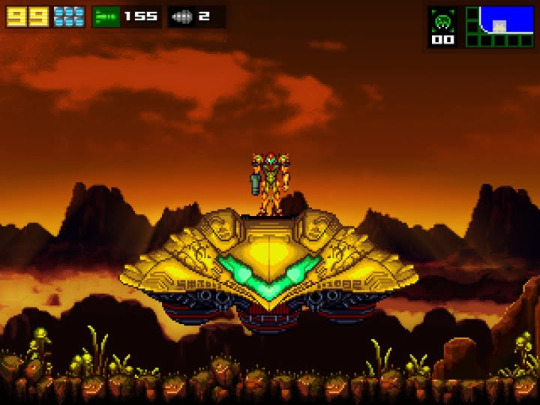
2 notes
·
View notes
Text
Metroid Retrospective: Metroid Pinball
Metroid Prime Pinball came in the mail yesterday and so, after nearly 20 years of wondering what it was like, I got to experience it. And... I'm underwhelmed.
Look, I know it's just pinball, so you might be wondering what I was expecting. And my answer would be: more variety. More creative ideas. More incorporation of the feel of Metroid, instead of simply a skin over what is actually pretty basic pinball.
Most surprising are how limited the boards themselves are. They are limited in number, to 5 that you can easily access, a 6th that is only accessible via multiplayer -- don't ask me why -- and a 7th that is a final boss fight and gated behind some stringent requirements. But more than this, they are rather simple, with a lot of repeated mechanics and really two main layouts that see only slight adjustment across the various stages.
I can picture a Metroid Pinball game where you have to progress through multiple interconnected boards via different colored doors, collecting items in some boards (like missiles) to be able to backtrack and open doors in older areas, leading to yet new areas. Or finding secret paths once you reach a certain number of points that let you bypass some of this. I picture multiple mini games activated by different areas on the board. I can even picture save rooms, if you can get inside them, which let you continue from where you lost your last ball. In short, I can imagine a Metroid game that uses pinball controls to progress towards a non-pinball goal, offering an experience that is more skill based than luck based.
And this imagining is actually supported by concepts present in the game. The boards are connected (although via warp points and not organically); there are items to collect (though their uses are minimal and don't aid in progressing from stage to stage); there are mini-games, though only two and they don't demand much in terms of reflexes or timing. The result is a game that promises a lot but is actually very shallow waters.
The blame, I think, comes from a confusion as to who the market for the game is. The clear target is a casual pinball market but the theme is Metroid, which is not a casual gamer's game. Casual gamers will be turned off by the innovations that are present while Metroid gamers risk feeling underwhelmed -- as I did -- by the lack of follow through on these innovations.
Within 2 hours, I had topped the pre-set high scores, even coming within 20 seconds of beating the world record on one level (Ancient Temple). And I can't claim that it was due to skill: I was really just slamming flippers and lucked out. At this point, there isn't anything left for me to do expect pursue beating my own high scores, which is diverting but not particularly engaging.
Hey, it looks very pretty, though.
1) Super Metroid
2) Metroid Fusion
3) Metroid 2 (original)
4) Metroid Zero Mission
5) Metroid Prime Pinball
6) Metroid (original)

2 notes
·
View notes
Text
Metroid Retrospective: Metroid 2 (OG)
One nice thing about most Metroid games is they are quick, this retrospective is moving right along!
Metroid 2 (original version) complete. Time to completion: 3:39 (aside from Super Metroid, which I could play in my sleep, I'm seeing a trend in these completion times). Item collection: 90%.
One of the key questions I had going into Metroid 2 was could I fairly talk about an old gameboy game in terms that weren't simply drawing upon nostalgia? You see, while I haven't played it in 25 years, Metroid 2 made an impression upon me as a kid. It felt massive and fairly difficult and yet I was able to persevere and beat it. I even remember where I was when I beat it -- in the car on a road trip back from Mt Hood, while my ears were still popping from the pressure and a small cold I had. So my question was, is there any reason besides nostalgia for someone to pick up the game today?
Several things surprised me during this replay. The first was how much more satisfying the graphics were here. Despite the gameboy having no colors and less graphical power than the NES, I think Metroid 2 is more aesthetically pleasing thanks to larger sprites and more details in the animations. It just looks good, and the game works around the color restrictions by setting everything inside dark caves and metallic labs, which you picture in drabber colors.
The second was how much had been fixed from my complaints of Metroid 1. You can duck and shoot, you can shoot down while jumping, there are full health and missile restore stations, save stations, and enemies drop health much more frequently.
Then there are more subtle changes. The game's structure is less maze-like, though it maintains the illusion of a maze. See, it does something that wouldn't be tried again until Fusion, which is essentially that the game is broken into unconnected areas, all radiating off a central hub, a giant shaft boring into the earth that more or less runs straight to the final boss of the game. This hole is filled with acid and you have to hunt down a certain number of metroids in each of the areas before it lowers, giving you access to the next area. What this boils down to is a game with minimal backtracking and only within the confines of each individual area. It makes for a game that feels really big and sprawling but subtly limits your explorations so it's actually difficult to get lost.
Along with this, the game's counter showing how many metroids remain on SR388 gives you a sense of constant accomplishment, watching it diminish until the very last metroid. It gives a far greater feeling of progression than the first Metroid, where you really don't know where you are going or what you are doing and have to just wander around, checking every single room for secret passages until you find a boss.
The end result is a game that I can only describe as addictive. That constant forward momentum and feeling of "the next metroid is just around the corner" makes for an experience that is hard to find a good pause to. I've played a lot of Metroid over the last few days and have, outside of Metroid 1, enjoyed myself, but Metroid 2 was unique in that I couldn't put it down and even woke up in the middle of the night with a need to get in another half hour and see if I could find the last ten metroids.
This makes it a difficult game to rank. I have to acknowledge that it is an old game lacking any color, with music that has to be the worst in the series (aside from two or three great songs, most of the soundtrack sounds like your gameboy broke and is crying for help), that doesn't have the flash and bang of modern games, and can feel monotonous in its pacing.
And yet, there is the fact that this is the one I couldn't put down, all the way up to its famous ending, from whose themes the entire rest of the Metroid saga was spawned. I suppose the real question is, would I soon return to this one? And that's where the answer really comes. Because while I was enthralled from start to finish, there isn't a lot of reason to come back, as it is a very linear experience, and many other ways to experience Metroid 2 should I care to do so (and which I will do twice more in this retrospective).
1) Super Metroid 2) Metroid Fusion 3) Metroid 2 (original) 4) Metroid Zero Mission 5) Metroid (original)

1 note
·
View note
Text
Metroid Retrospective: Super Metroid
And Super Metroid complete. For the 50th time in my life (I haven't kept track but I wouldn't be surprised).
Completion time: 2:05 (I could have done sub-2hr but I went to some of my favorite unnecessary rooms just for fun and took an extra minute to "save the animals")
Item rate: 55%
Super Metroid is a phenomenon. Released in March, 30 years ago, it remains enjoyable, approachable, fresh, and relevant to this day, an accomplishment that few other games can match, and extremely few action/adventure games.
Also, few games do atmosphere this well. Even coming recently from games with far more complex graphics, like Zero Mission and Fusion, there is something wonderfully somatic about the sprites used in Super Metroid. Sprites might not be super detailed, but they feel "weighty" and enjoyable to look at, the same way old cartoons (in the style of Cuphead, for instance) are just fun to look at. Super Metroid's art is simple but perfect. Every single bit of every single graphical block or sprite is absolutely necessary to illustrate what it is and give the feel of it, and no bit is wasted. It's like it has found the purest essence of sci-fi, action, and horror. The same praise extends to its soundtrack. And honestly, even to its story, which is distilled down to the most critical parts and which still leaves me emotional after 50 times viewing the ending. The whole thing is timeless.
Beyond this, the lasting nature of the game comes down to the move-sets given to Samus and the willingness of the developers to let players use these move sets to sequence break -- to break the order of play that the developers intended by reaching items, locations, and bosses early. I'm not a master sequence breaker, but as an example I managed to reach Kraid without the High Jump and to collect the Wave Beam and Power Bombs early, which saved me about thirty minutes of playtime.
Because of this openness, Super Metroid becomes like a huge playground. If you are new to it, then it leads you on an exceptionally atmospheric journey, with scripted moments and sprite animations that still are impressive and well paced in 2024. For these players, they may never even discover half the moves you can do, like Shinesparking and Turbo Bombing, because they aren't needed to beat the game.
But if you are experienced and know how to use these tricks, then the game becomes something else entirely, a series of reflex challenges to see how much you can "break" the game using these techniques. It's like a game that made glitching part of its mission (because the game doesn't actually glitch out when you sequence break).
I think that many open world games which claim to give the players choices actually don't; they give the illusion of choice but compensate by making those choices unimportant or very brief in their effects on the game world. Super Metroid, though it doesn't let you change anything in the story, actually does give you choices that matter and a world that is open world not by default but becomes more so the better at the game you get.
I only have one complaint about the game and that is that having to hold down a button to run is painful. Switching weapons is a little clunky, too, but doesn't ultimately disrupt my gameplay. However, I have no idea how I ever played this as a kid without realizing how awkward it is to have to constantly hold a run button.
There. I found something legit to complain about. One complaint against a game that forever changed the genre and has been the foundation for hundreds of later games.
World record speed run for Super Metroid currently stands at about 45 minutes, by the way. And people are still discovering new ways to beat it.
Current Ranking:
1) Super Metroid
2) Fusion
3) Zero Mission
4) Metroid 1
Games remaining:
Metroid Prime (SWITCH)
Metroid Pinball (DS)
Prime: Hunters (3DS)
Metroid II: Return of Samus (SWITCH - Gameboy emulator)
Metroid II: Samus Returns (remake of II) (3DS)
Metroid Fusion (SWITCH - GBA emulator)
Metroid Dread (SWITCH)
Fan made: Another Metroid 2 Remake
If I can find a way to play (have played in the past):
Prime 2 (WiiU via Prime Trilogy)
Prime 3 (WiiU via Prime Trilogy)
Other M (Wii)
Not playing:
Federation Force (3DS)

2 notes
·
View notes
Text
Metroid Retrospective: Metroid Fusion
More completed in my Metroid run. Today I finished Metroid Fusion.
Time: 3:44 (60% item rate).
This is one of the few Metroid games with an actual story beyond "land on planet kill all enemies," so to briefly set the stage, Samus nearly dies at the beginning of the game when she is attacked by a strange parasite. After her life is saved by Metroid DNA, she travels to a space station where an outbreak of the parasite has occurred and soon finds herself in Nintendos handheld version of The Thing, where the parasite is mimicking monsters as well as a fully powered version of herself, which hunts her across the station while she tries to figure out a deeper mystery of what the station was for, all while being led by a Federation AI.
Note that very very few of these games are ones I am playing for the first time, though it has been a while since I last played Fusion amd i was surprised by how new it felt. It is a game that has aged remarkably well and feels like it could have been constructed this year. It is a very well tuned experience, with a huge emphasis on taking all the elements of Metroid gameplay and making them more precise, faster, and more active. It has some of the most satisfying combats in the series and there is a true sense of accomplishment to be found in its completion. You have go get good at the game and you have to get good fast, but it is so easy to control that this feels rewarding rather than a chore.
The only complaint one could levy against this game is it's sheer linearity -- there is no sequence breaking, very little opportunity for backtracking, and a point of no return that comes right after you get your final ability... which means you don't get to use it to go explore area that were specifically blocked without its use. Admittedly the game does let you reload your save after completion and them you can freely explore and round out your item rate, but some momentum is lost in this. Essentially, the exploration aspect is a "bonus" mode, not integrated into the main experience.
In a less well directed experience, this linearity could be a real mark against Metroid: Fusion, but here it is put to incredible use, crafting a game that is shockingly suspenseful, that somehow manages to pull off jump scares on a 2D side scroller, that envelops you in atmosphere and discomfort and gives you just enough tools (barely enough) to have a fighting chance. I can't complain about linearity when the roller coaster is this fun.
Current ranking of games:
1. Fusion
2. Zero Mission
3. Metroid 1

0 notes
Text
Metroid Retrospective: Metroid OG
Continuing my "all Metroid games I can get my hands on" run with the original Metroid. This may be the only one of the lot I don't actually complete (aside from Federation Force, which I don't even intend to play).
I'd heard from many many people that the OG Metroid has aged incredibly poorly, far worse than its other contemporaries like Ninja Gaiden, the OG Zelda and Mario, and Contra. And I can't argue, even with the generous addition of save states and the ability to rewind that the Switch adds. It is not a fun game to play.
There are things I enjoy. I actually like the labyrinthian nature of the game, which forced me to draw maps and work out where to go next based on where I'd explored. There was a wonderful rush of satisfaction every time I found a new path forward or discovered a secret passage and expanding my own hand drawn map was its own reward.
I also enjoy the difficulty of combat. Enemies move in predictable enough patterns that as you learn them you can start abusing these patterns, leading them into your missiles or shots with a feeling that is remarkably ahead of its time in terms of making you feel like you are in a gun fight. It's another way the game rewards your continued play as it has a limited enough roster of enemies that you really do get better at playing and can see this in the fact that you start making more progress on the map. You can even start using certain spawning enemies as "farming" to restore your energy and missiles by taking them out over and over.
However, there are two things that hurt each of these "likes" pretty massively.
The first is that you can't duck and fire. This wouldn't be an issue except for the sheer number of ground enemies. Yes, you can jump over them but it just doesn't feel right to not be able to shoot down, even while jumping (you can shoot in every other basic direction, but not down). It makes for a lot of situations where rooms are harder than they feel they should be, simply due to mechanical limitations.
The second is more aggregious: when you die you start with a ridiculously low amount of health. Not full health, no. Not even one full energy tank (which is 99 energy). 30 energy. That's what you get. And that sucks because there isn't any "full restore" stations. Instead, you have to go camp in front of those forever spawning enemies and monotonously take them out over and over until you are full health... which of course, as you progress and get more energy tanks, takes longer and longer. It's a strange reversal of player reward, where the game actually gets MORE frustrating as your health bar gets higher and I can't imagine this was an intentional effect on the part of the designers. I feel like it was more just a sign of the early days of gaming and lack of experience creating a system that was antithetical to player growth.
And the enemy drop rate is not high. I spent 20 minutes one time restoring all my energy, only to fall in acid and get stuck and die two minutes later. That was about the time I realized I probably wouldn't finish Metroid 1. It's a shame, because if you just had some instant restore stations, I think this game would still be as good as Zelda, Mario, and others. But that one aspect just takes the lengthy exploration and getting lost in the maze-like Zebes and makes it tedious instead of tense.

2 notes
·
View notes
Text
Metroid Retrospective: Metroid Zero Mission
Round one in my Metroid RePlay: Zero Mission.
Time to beat: 3 hours (62% item rate)
Long before the remake craze took over, Metroid Zero Mission set the standard for what a true remake and not just remaster should look like. This is Metroid 1 as you imagined it as a kid, all the sprawling depth of the planet Zebes actually realized, with true action set pieces replacing the moment to moment danger of the original. It is a fast paced game that makes it easy to play in a single sitting as there are enough new gameplay concepts spaced out across the experience to alway make it feel fresh.
I actually think it's a little too fast paced at times, so that I feel like I'm blazing through the game with little challenge or reason to take in the beautifully crafted environment. Which can actually impede gameplay, as there are several moments where in order to progress you have to pause and really study the environmental clues. One memorable one involves figuring out how to get past these big plants blocking your way (I won't spoil the solution here). But I missed this for a while and it didn't feel like my fault... the game's insistence on speed was at odds with this aspect of its design.
It is a small thing in a game this good but as someone who enjoys the atmosphere of Metroid a lot I did feel at odds with the pace for much of the experience (the ending sequence being a notable exception and proof that a slower pace could have been more effective). Fun and exciting but rushes through it's own thrills like a child wanting to show you everything at the zoo.

3 notes
·
View notes
Text
Is there more Alignment May Vary?
It has been over a year since I last checked in, but wanted to answer a question that came up recently. That question was... is there more AMV?
The answer is no. For a while we hosted a website with some audio versions of the adventures and a podcast called the Bestiary, but that has since gone away. I do have some art from that project that I will share here!
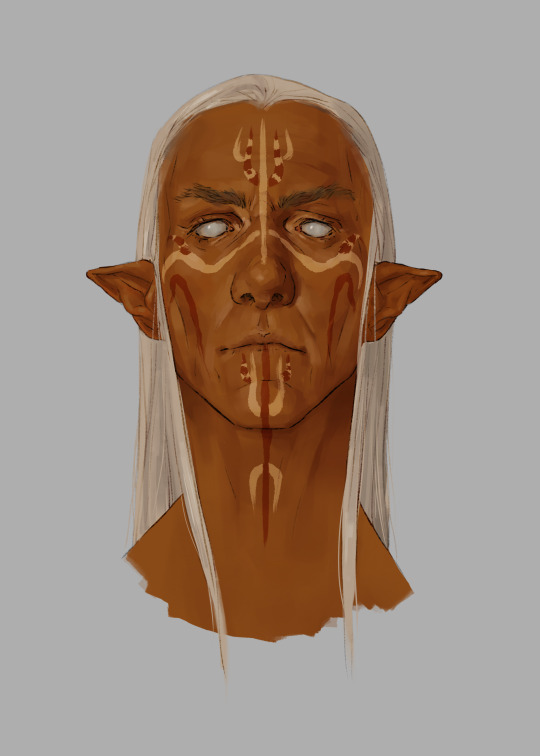
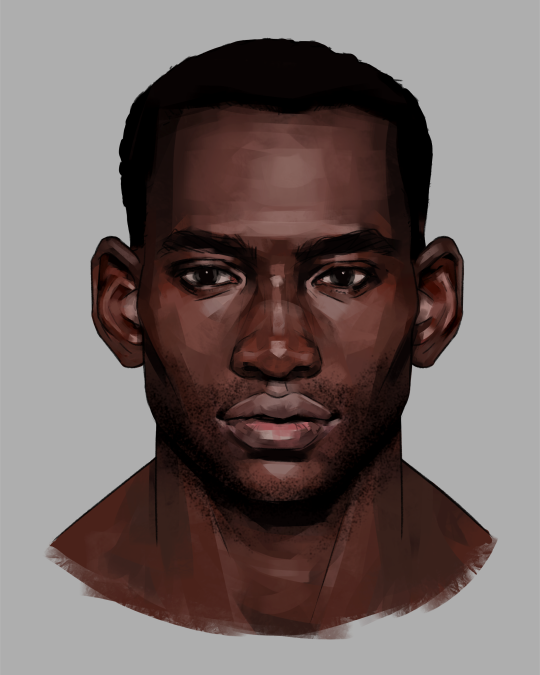
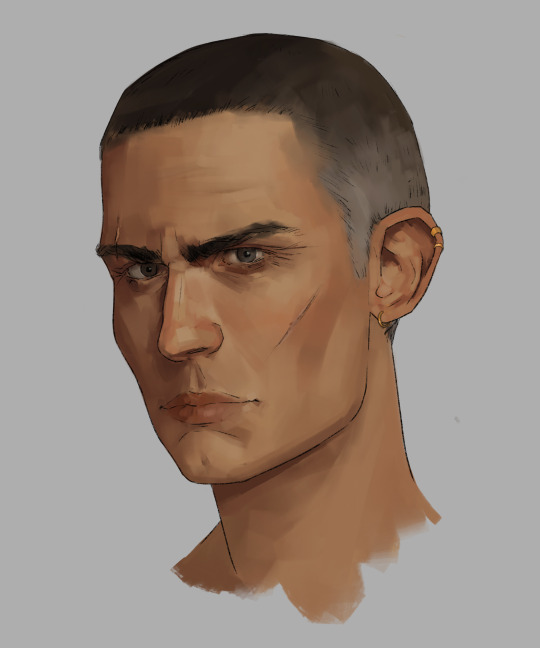

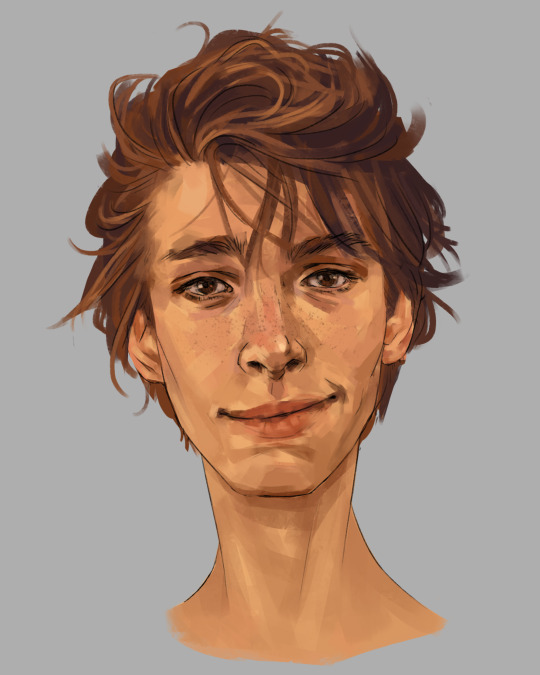
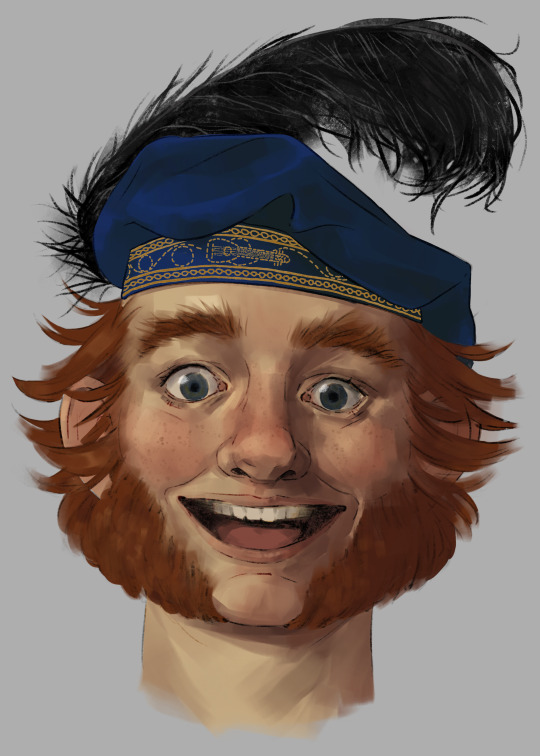
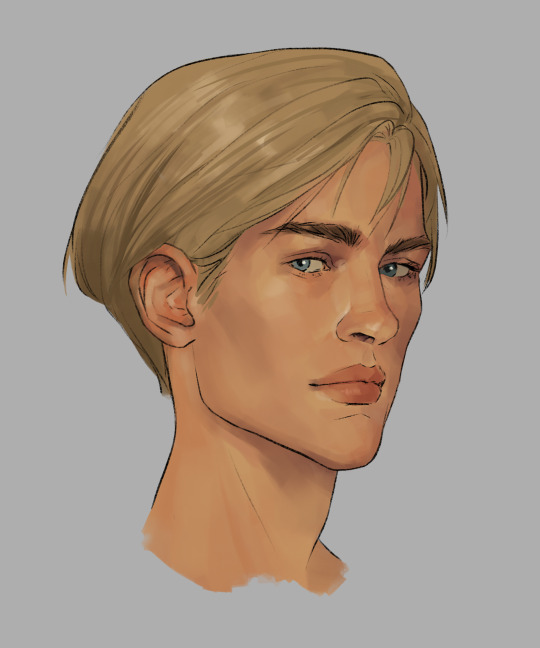
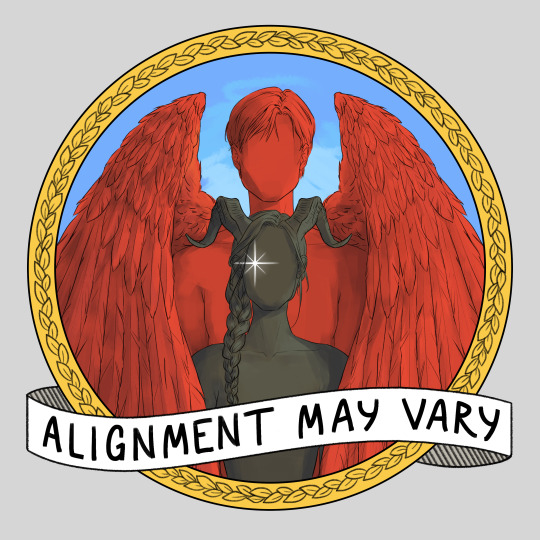
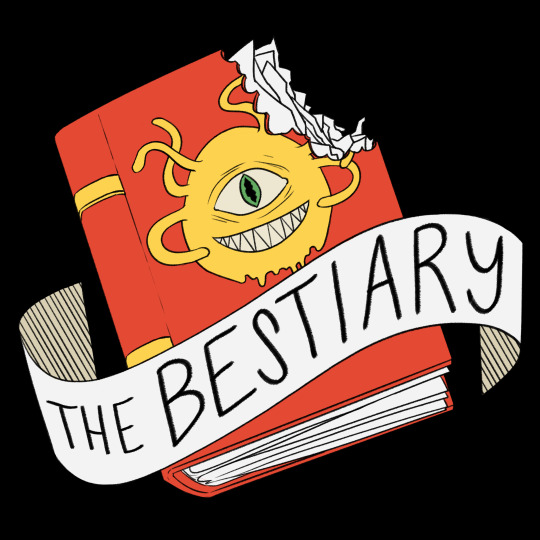
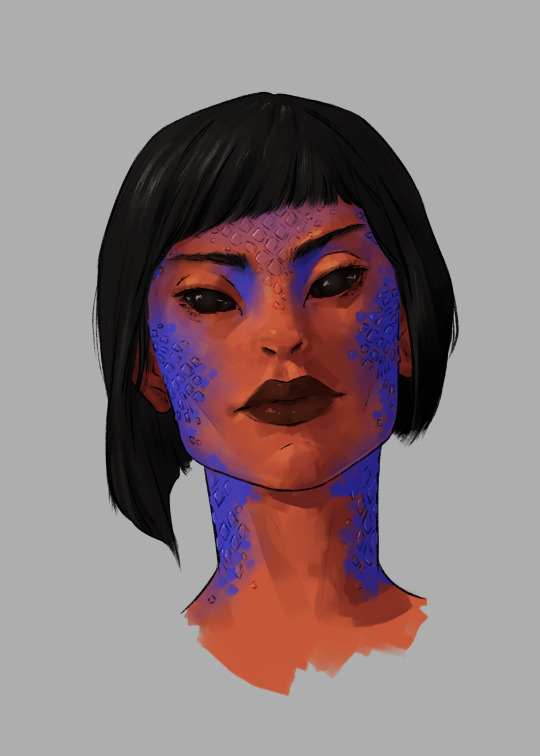
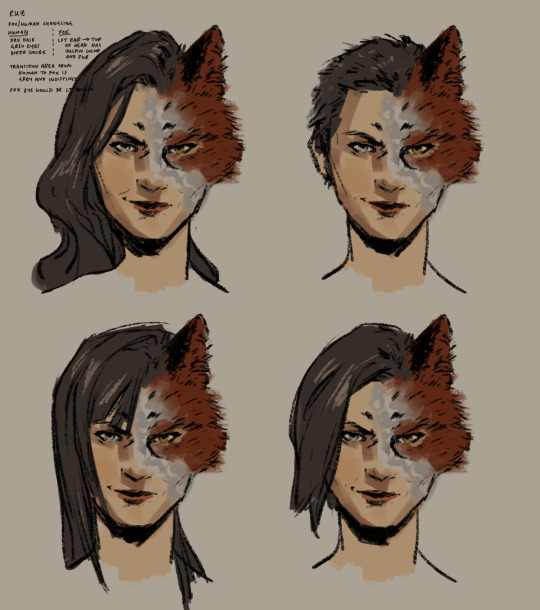
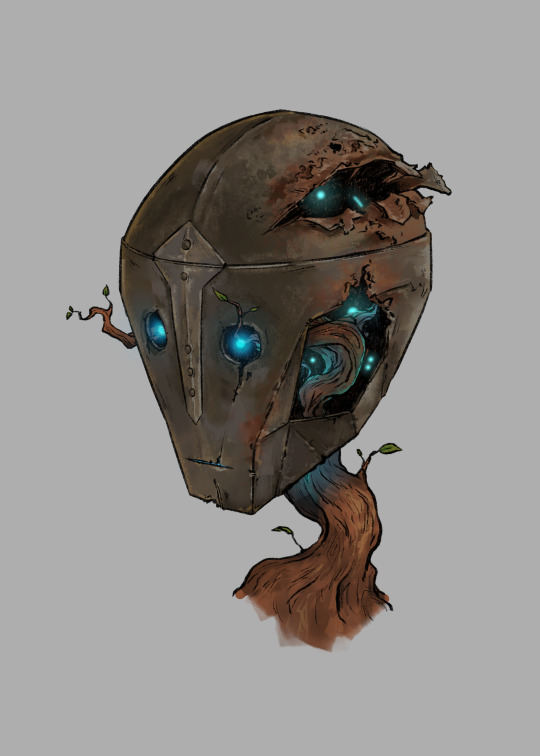
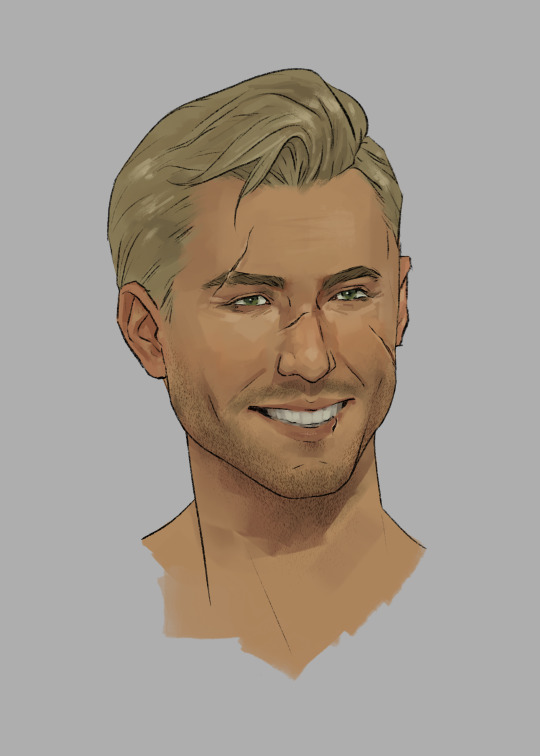
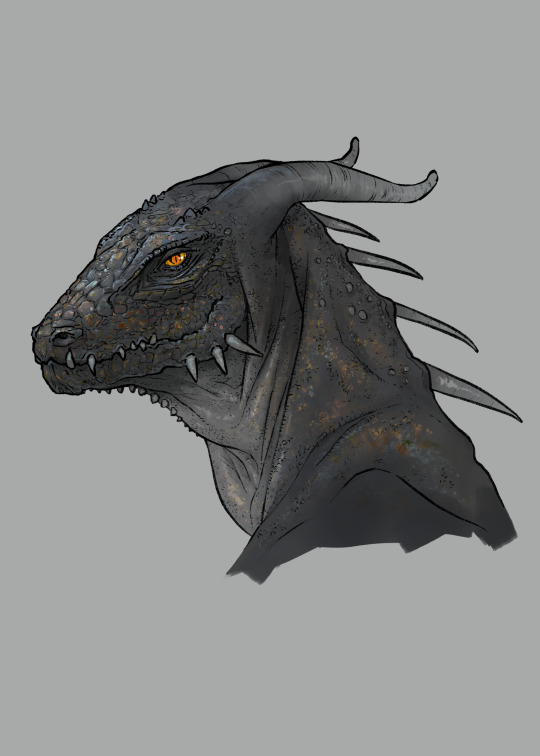
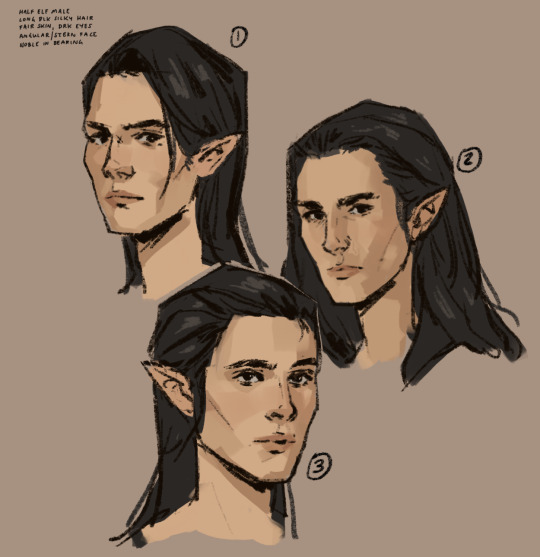
Going down the list, from left to right, top to bottom...
Trakki, the biind elven monk
Shando, the masked fighter
Twyin, the cursed soldier (renamed Lorin in our later notes)
Karina, Tiefling spy, Seeker of Callax, and the 1st main character of AMV
Targaryan, the psychic boy (renamed Daymos in our later notes)
Tyrion, the halfing bard and later possessed warlock (renamed Bitterberry in our later notes)
Abenthy, paladin turned villain
Our AMV logo
Our Bestiary logo
Imoaza, Yuan-Ti wizard and later Shaper of the Weave
Concept sketches for Ruiz, a shapeshifter
Milosh, the "green" robot found in deep space
Adric Alwright, mercenary
Nysyries, dragonborn pirate
Concept art for Carrick, elven warrior and clone
We still play D&D and other RPGs but life has changed drastically for me. The week before we started AMV I got married. By the time it had ended I was about to become a father. Now my son is two and a half and I am about to become a published author, and I also work full time while producing a podcast for the Lone Wolf series (if you haven't checked out Lone Wolf, do so! You'd LOVE it. www.magnamund.com).
What all that amounts to is that I no longer have time to keep track of a massive story like AMV by writing it all down. We still have epic tales... but I don't have the energy to share them publically. Also, while we've had some insanely good adventures -- complete with tears and the whole works -- nothing can really come close to this game. It just was... incredible. An experience that can't be copied or emulated. It stands alone.
If you haven't checked out AMV, you can read the entire 96 posts here on my blog! This is the beginning.
1 note
·
View note
Text
Part 96 Alignment May Vary: A Farewell to Friends
If you’re reading this post after having read all 95 other posts, bless your heart. This is truly the final post, the last one in the Alignment May Vary series. If you are just stumbling upon this randomly, you may want to go back to at least the previous post “The End of All Things” as this is a direct continuation of the final battle described there. Also, many previous posts are linked there to help give at least some context to the encounter. You may even want to go back to the beginning and read the whole epic story. It’s the internet’s most massive and complete campaign journal!
This ends with the final lines of our campaign. I will not say farewell then, so I will say it now. The goal of this journal was to bring some small measure of the enjoyment and wonder we felt making this story and playing this game for four years to you. I hope it achieved that, and thank you for reading.
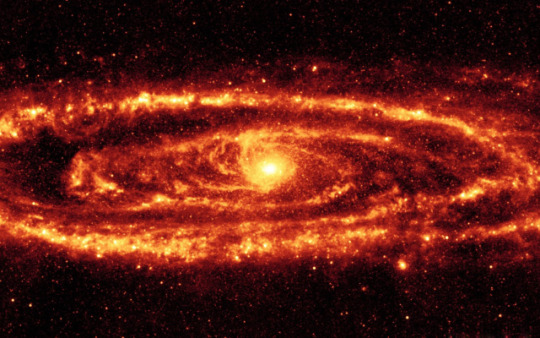
The Destruction of All Things
Meteors, the debris of a hundred destroyed worlds, or maybe worlds that had yet to be destroyed in this timeline, rained down upon the Maakengorge tower, breaking it into dust, revealing the infinity of space behind it. Imoaza tried to pull a barrier around them, made of the weave, but the weave did not obey her here. It did not even exist here. Nazragul had cut its strings. Imoaza fell under a maelstrom of heat and rock. Milosh survived a little longer, smashing the rocks with Haggemoth’s forge hammer, Haggemoth’s greatest weapon. If he could only get a clear shot on Nazragul, he thought he might be able to unleash Primus’ power on him and end this now. But Nazragul himself was engulfed in flame and Milosh drew close only to be burned and fall away into ash.
Carrick was the last to struggle on. Imoaza’s fly spell died with her, and yet momentum continued to carry him towards Nazragul. He raised his blade, knowing he would only have time for a single decisive strike. Then from the flames a skeletal hand shot out and gripped his wrist, holding him. Nazragul leaned forward, his face a grinning skull.
“I win,” he said and held Carrick as the meteor swarm crashed through them both, sending Carrick to join his companions in death.
Darkness surrounds the players. Wonderfully, they think they have lost this fight. But in reality, they have won. They brought Nazragul down to the point where he had to use his most devastating attack in a desperate gambit to destroy them forever. It ripped apart his body, as well, but he can regenerate. The players cannot. Or so he thinks.
In fact, this would have been the end of the party, except for a particular deity they helped some time ago. Now, that deity appears to them on the border of life and death. Asmodeus, lord of the Devils, and his new queen, Alyss, come to the players in purgatory. When the call comes from darkness as to who would claim the souls of the players, it is Asmodeus who answers. And then, having laid his claim, Asmodeus grants their souls new life, a return to their bodies, each of them at a single hit point.
“This is my boon, my one and only repayment for the service you rendered me. You returned me to my body and my realm, now I do the same unto you,” Asmodeus says.
“Save my daughter. Bring her soul peace,” Alyss says.
And then they go back.
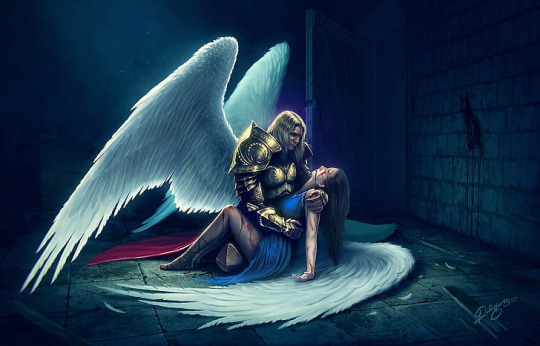
A Decision Made
The players return to a world destroyed, a universe ending, a time that could come to pass, but hasn’t yet. A space between time. And in this space Nazragul sits. The body of Abenthy that he wore is destroyed. What squats on the last remaining piece of ground in that floating nothingness is a shadow, a whirling of darkness.
And now, in front of it, stand Carrick, Imoaza, and Milosh.
“N-nooo....” the dark shape mutters. “Y-y-you are a-a-ll... d-dead...” it can manage no more. But its power is growing by the second, its body repairing, rebuilding.
There is no time to waste.
“One of us must be the shield, the sacrifice,” Carrick says. “We must take on the soul of Primus.” He holds up the Surveyor’s stone, containing the spark that can link Primus to one of them.
“It’s me,” Milosh says. “I’ve already lived a life. This is all borrowed time. It is what I was meant to do.”
“But I have lived a life as well,” Carrick begins to protest.
“No,” Milosh says, the half-orc shaking his head somberly. “You never got to live your own life. The Surveyor took it over from you when you were still young. It needs to be me.”
Except, it doesn’t, Imoaza realizes. It doesn’t need to be any of them. She is peering at the weave, magic made tangible to her special abilities. And in that weave she sees a line that has not always been there. It is like a silver thread, allowing for a different path. She recognizes the lifeforce in that thread as having belonged to Ruz. Ruz, who used her wish spell to save everyone at the Maakengorge, who has become part of the weave itself in order to work that magic. Now, the last remnants of that powerful wish are there for Imoaza to use. She grips it, and instantly she can see everything, the way the weave ties together not just magic, but the whole universe. She pulls on those threads carefully, for they are delicate and she could easily do more damage than good. She pulls, and three souls emerge from the darkness that is the thing in front of them, the thing Nazragul became, the Three who rule as One.
Nazragul is the first soul and this soul Imoaza chooses to be their shield. This will forever erase him and Primus from existence, which will also destroy Chaos. But even after this, Imoaza has a little of Ruz’s power left to use. She can, she realize, bring one of the other two souls back to life: either Karina or Abenthy. They are fading fast though and the decision must be made.
Abenthy and Karina stand now before the group, and I ask their players (who now play Milosh and Imoaza respectively) to give them voice, to have a conversation between them about what choice they should make. And so the players roleplay the moment as Karina and Abenthy get to see each other one last time.
“I am sorry,” Karina said, seeing Abenthy again, seeing his grim mission lifted from him. “I am sorry I could not save you.”
“It was never your fault,” Abenthy says back. He kneels and places his sword on the ground then, turns to Imoaza. “It is time. Rebalance the scales.”
This moment is too much for all of us at the table, and the tears start again. Also, Imoaza cannot decide which of them to save. The player ends up having to roll a die to decide for her, it is too heavy a burden to take full responsibility for.
And the die decides it is to be Karina.
And so, in the final moments they have before the souls retwine and the body of the Three in One rises again, the deed is finished. Milosh opens his chest panel and the power of the Inevitability of Justice emerges from him to engulf and destroy forever the souls of Nazragul and Abenthy, as well as Primus and Chaos. Karina is reborn into her body and lands next to them, naked. Carrick wraps his cloak around her.
Then, as the final wave of power leaves Milosh, the space time that they are in collapses. They are rushed back to the world they left behind.
They return to a world saved.
The portal opens, the mountain collapses. The four emerge in a sea of white snow, wondering if their actions doomed their friends outside, who may have been buried when the mountain was destroyed. But then the ships of the Githyanki land around them, and there is a great cheer, for the armies were loaded onto the ships, and their friends saved. The last Surveyor approaches Carrick and Milosh and tells them they are both free now. Everyone is free, free of the creators, Primus and Chaos, to form their own future. All bonds are broken, except those kept in the name of honor and of love. The Surveyor then lays down in a patch of snow and closes his eyes for the last time, telling them all to seek their destiny wherever they feel it is best found.
And so the companions do. Each player makes a choice as to what their character does next, and we get some wrap ups on some of the NPCs, as well.
Carrick speaks to Roger Krisp, saying he would like to join the Green Company to keep a promise he made to Aldric. Roger gives him the Anope and lets anyone who wishes to follow him do so. For Krisp, he has spent decades trying to return from Hell back to Faerun and he takes his second in commands, the adventurers who long ago trialed the Tomb of Horrors (and died doing so) and buys a new ship: the Mankey Bastard Mk II (AKA the Mankier Bastard). He returns to sailing the seas.
Carrick swears his services to Aldric’s daughter, Sasha, and says that he will be off to sail the galaxies with the Green Company to do good throughout the universe.
Imoaza has responsibilities here on Faerun. She approaches the Yuan Ti, who are unsure of what to do next. They ask her who they will be conquering next.
“No one,” she tells them, knowing this is a moment that will define the rest of her people’s existence. “We will find a new way, a better way. The way of the dragon. The way of peace.” And Hecate is the first to bow and swear fealty to her mother, now the mother of all Yuan Ti, Imoaza.
For Karina, this return to life is full of emotion. Verrick and her embrace. Verrick’s bonds that made him a Death Knight are broken, and he is able to resume a life with her. Karina also greets many old companions whom she has not seen in generations. Roger Krisp, Daymos, and Jade. Jade in particular Karina is overwhelmed to see, as she felt responsible for her loss to Nazragul in the first place.
Milosh’s chest plate is gone, his full body finally restored to him as a last act of Primus. He is given many choices now. Carrick says he could have a place among the Green Company, or if not, he would be happy to find his home planet of Eberron and drop him off there to resume his old life. Breathgiver the shaman offers him the Blackstaff, saying he could stay and rule Waterdeep, help rebuild Baldur's Gate, Ottoman’s docks, and the other cities which were destroyed by the Tarassque. Milosh thanks everyone and says he will decide in the morning.
But in the morning he is gone, and no one is quite sure where he left to.

Epilouge: A Farewell to Friends
This scene takes place 16 years after the final battle. The player characters are asked to come to Karina’s academy on the old island of Thudd, now called Oasis. It used to be a school for adventurers, trying to train people to eventually face a darker world, in case Nazragul’s plan came to fruition. Now it is a school of knowledge and philosophy and healing magics.
Karina was old before the final batle, and though restored to her body, she still only had scant years left. She is now passing, and everyone has been called to honor her in her final hours and say goodbye.
Of the companions, we follow Carrick, who arrives with the Green Company in the Anope. He wears shining emerald armor under a green cloak. Under one arm, he holds a small, wrapped package.
He finds some new additions to the school grounds. There is a hall named for Shando, one for Daymos, and one for Lee. And in the central plaza is a bronze statue of Abenthy, not as the final terrible thing he became, but as Karina remembers him at their first meeting, and their last. A noble paladin. On the plaque at the statue’s feet is inscribed the words: “Justice is Inevitable. Friendship Does not Die.”
“Swords are easy,” a familiar voice said behind Carrick. “Capturing the look in someone’s eyes? Now that’s hard.”
Carrick turned to see a smiling half-orc standing beside him, wearing a simple tunic.
“Milosh!” Carrick said and embraced his old companion. “Where have you been all these years?” he asked, once he had let him go.
“Learning the trade of blacksmith,” Milosh said. “It seemed an honest profession, and Karina agreed to let me stay on and keep my secret.”
“I would have thought you’d be ruling Waterdeep, or Baldur’s Gate, or out adventuring even. There is still always a place for you among the Green Company.”
“You are still riding with the company?”
“Mostly. I leave most of the running of it to Sasha. She has the knack for leadership. I have focused on teaching. I have created a new order of Paladins, based around the tenets of an old friend of mine who taught me some dear lessons when he was alive. The School of Remus.”
Milosh smiled and nodded. “There is much to be learned from old friends. Your offer is a kind one, but the night we defeated Nazragul, the Surveyor told us to seek our destiny where we felt it was most likely to be found. I realized then that I had spent more years than most people get to live fulfilling other people’s destinies, solving other people’s problems. I thought maybe it was time for me, for the first time in two lifetimes, to live a life for myself. I settled here with a wife and we have a child. I am living every day filled with a contentment that I thought was not mine to have.”
Carrick clasped his shoulder and smiled. “I have watched you go through pain and loss. It is good to see you gain something. Good to see you happy.”
“Have you seen Imoaza yet?” Milosh asked. Carrick shook his head. Milosh’s own smile softened, became a little sad. “I’ll take you to her.”
Together they walked into the main hall, the hall of Heroes, where a line of tapestries depicted famous events in the history of Faerun. Before one tapestry, which showed humans breaking free of Yuan Ti slavery in the days of yore, stood an old Yuan Ti Pureblood, her hair white, her skin wrinkled, one hand holding a quarterstaff to support her weight. On one shoulder fluttered a greying ball of fuzz, that chirped softly: “chi chu!”
“There’s a tapestry of us three,” the old Yuan Ti said. “In our final battle at the Jarlsberg. I think they went a little dramatic with me, though.”
“Imoaza?” Carrick asked. The Yuan Ti turned and nodded her greeting. She had always been reserved, Imoaza, and time had not changed that. But it also looked like she had aged seventy years in the fifteen since last they met.
“Don’t look at me like that,” Imoaza said. “All three of us cheated time when we left the Abyss and ended up back on Faerun. You two paid for it with your lives. This is now my price. I am not yet gone from this earth. Time has just caught up with me, at last.”
Carrick found his eyes watering. He wiped at them as discretely as possible, but Imoaza, who had always had the sharpest eyes of them all, of course noticed. “It is alright,” she said gently. “I have accomplished what I set out to do. My people will go on. They are not powerful, but they are stronger, and better. They walk the path of balance and of nature. We are farmers, gatherers, druids. Peace suits the Yuan Ti. We take to it as seriously and studiously as we took to war.”
Carrick nodded, then said, “I have something for you.” He held out the small package. “I made a special stop at an old favorite of yours on the way back to Faerun.”
Imoaza unwrapped the package to reveal a host of sweet pastries, beautiful in their presentation, the smell of cinnamon and baked sugars rising into the air. Imoaza giggled like a little girl. “Air pastries!” she exclaimed, and reached into the bag, tearing off a piece of one of the gooey rolls, leaving strands of maple training in its wake, then popped it into her mouth and chewed, her grin growing wider.
“I’m sad they did not make a tapestry for that place,” she said.
A door at the end of the hall opened then, and an attendant of the school hailed them.
“It is time,” the attendant said.
The players enter through the door to find themselves in a grand room with pillars open to the outside, looking out upon a fabulous view of falling waterfalls and green trees, maybe one of the greatest signs of change that Karina ever brought to the world, her successful changing of the Desert of Thud into the Oasis. There is a bed here as well and on it lies Karina, her white hair braided, a cool breeze blowing through the room caressing her brow.
Many people are gathered here to say goodbye.
Daymos and Jade are there, and with them Reeves the Quasit. The brother and sister hold hands, and both are crying. Karina had witnessed both of their deaths, but also their rebirths.
Hazelwood, Ruz’s daughter and the inheritor of the power of Esheballa, has come on behalf of the Changelings whom Kaerina once sheltered when no one else would.
Milosh and his family stand in the back of the room, his half-elf wife and child both holding his hands, hands which once were literally guns, now which create instead of destroying.
The Green Company is in attendance along with Carrick. Aside from Carrick, they did not know Karina personally, but they have learned of her deeds and come now to be her honor guard as she passes.
Imoaza is the only from the Yuan Ti here to say goodbye. Hecate was left to run the Yuan Ti kingdom in her absence. Imoaza uses her weave vision to see that Karina’s life is fading but she also sees the way that life has touched so many others.
Captain Krisp comes, with the full crew of the Mankier Bastard, his new ship. He tells Karina he will name a new brand of his cereal in her honor. “Karina Krisps?” he mumbles, liking the ring of it.
Immerstal the Red is present. Knick Knack comes in his fire form all the way from the Planet of Fire. A Red Wizard arrives, holding a framed portrait of Lhu Ee. Senator Nakir, once Karina’s Apprentice, arrives from Waterdeep, with Blackstaff Breathgiver. Traki's brother is here, as are many other elves, for Karina was a great ally to them.
There are monks here, too, from Abenthy's old monastery, as well as the sister's of Celaenos, come to honor the one who saved Abenthy’s soul and to record this moment in time.
Giants and kobolds and orcs and hobgoblins all arrive, those who repented after the final battle with Abenthy.
Most surprisingly, there are dwarves here: the distant descendants of Haggemoth’s line, who have heard of how their ancestor's soul was finally saved and their family line restored to honor. They are here to give thanks to those who helped that come to pass, which includes Karina.
And finally, there is Verrick, kneeling at Karina’s bedside, holding her hand. He does not know how long he might wander the earth without his love, and he cries to think of life without her. But he is also happy, for the life she lived and the time they were able to share. And he believes they will be reunited one day, even if only to rejoin the weave that souls are built from, and be knit together into a new story, a new life.
Karina looks around her, at all these varied people, all the lives she has touched. She squeezes Verrick’s hand. Then she closes her eyes, and smiles, and Karina who had once thought she would always be alone passes, surrounded by friends.
#Alignment may vary#Karina#Abenthy#D&D#5th Edition#5e#boss#boss fight#boss monster#ending#campaign journal#RPG#D20
3 notes
·
View notes
Text
Part 95 Alignment May Vary: End of All Things
Here we are. I’ve been putting this off for a while, but this will be my final two-part post in the AMV campaign. This is the post that describes the end of our game, which happened on January 15th, 2021, over 4 years from our first campaign. It was an emotional moment for us all. I remember writing the notes the day before the session and then realizing I was sobbing openly as I wrote the campaign’s potential final lines. I thought, whew, well at least I’m getting it out of my system early. But the 4 hour session ended up being full of tears for us all, and once one of us started crying, the whole group couldn’t stop. It is impossibly hard to say goodbye to characters that you’ve essentially been the parents of, the creators of. And in writing this post, I’m doing it all over again.
This post was originally one long post, but I decided to break it into two pieces for ease of reading. If you’re reading this post after having read all 94 other posts, bless your heart. But regardless of how you arrived here, I’m glad you are here with us at the end of all things.
Our session begins right where the last one ended, at the foot of the Jarlberg mountain, at the summit of which Abenthy waits in the old cave of the stone giant Kirazov, for his ritual to complete and the plane of chaos merge with the material plane.
The PCs were saved in the final moments of the grand battle between the armies by Roger Krisp on board the renamed Anope intergalactic vessel, and a fleet of Githyanki who followed him to this planet to save the reality of those who had once aided them.
There is little time for reunion. Roger Krisp gives the PCs the last of the Surveyor’s remaining revitalization injection, which essentially long rests them all. They manage to save one: Imoaza took no damage during her stealth assassination in the last battle. Sasha, one of Aldric’s goblin children (his spunky daughter), has a brief and emotional greeting with the group. Time differentials in space travel (as well as speedy Goblin maturation) means she is an adult now, and she tells them that her father would be proud of them, and shows them that everyone on Anope has joined the Green Company to honor him. In death, he achieved what he had sought in life, the revival of his old Company.
(Cue our first round of tears).
Most surprising is the emergence of the The Old Surveyor from the ship. This is the old man from the Air Planet, who had disobeyed the orders of Primus centuries ago, and whose disobedience led to the creation of the “Progenitor Surveyor,” the one who created humanity and whom Imoaza’s ancestors worshipped long ago. He disembarks from the ship as well, now, and tells them that most will not be able to survive the “space beyond space” where Abenthy has fled to, so as to not be interrupted in his summoning of the Chaos Plane. He tells them that only Blackrazor can let them enter that space and allow them to do battle.
“He is no longer just Abenthy,” The Old Surveyor tells them. “He is a merging of three powers, three distinct lines of fate and alignment. Lawful, Evil, and Neutrality have all blended inside of that being. It carries the power of law, the knowledge of magic and the planes, and the determination of destiny.”
“We have the numbers,” Roger Krisp chimes in. ”It’s time to storm this mountain and end this!”
“Only these three can enter. Anyone else, anything else, would be torn assunder by trying to survive in that limbo. Blackrazor will keep Imoaza safe, the Surveyor’s Stone will keep Carrick safe, and Milosh's chest plate will keep him safe as it carries the true essence of Primus within it, the heartbeat of a god. Anyone else would be torn apart by what waits beyond. The fate of this plane of existence must be left in the hands of these three. Well, and one more, if you will grant him your protection.”
Out of the Surveyor's sleeve comes the Chi Chu, the little pet turned familiar that Imoaza hasn’t seen since entering the Abyssal plane ages ago. it flits over to Imoaza. They hear a "Chiiiii?" as if asking, you won't leave me behind this time, right?
(The return of a favored animal mascot? Cue our second round of tears).
With this, the group begins the ascent, though Carrick stays behind a moment to ask the Surveyor what will become of the Surveyors (of which Carrick and the old man are both technically the last) once Abenthy is defeated and Primus and Chaos’ soul erased in the process. The Surveyor says that for himself, it will be time to rest at last, and return to Primus’ side, even in oblivion. But for Carrick it will mean a different kind of freedom. Freedom to choose his own destiny.

"This is Where I First Learned to Hate”
As the group climbs the mountain, I remind them of the prophecy, to center us in on what this final session will cover. Friezurazov is the throne of power in the prophecy, a leyline in the world where reality can be weakened. It radiates power, and this power is what originally drew the Stone Giant Kirazov to the land, to make the Jarlberg (the seat of that psychic radiation) his lair. Now Abenthy has taken that seat back and from there plans the end of the world.
The party have to enter and pursue him, and Blackrazor Alpha, which Imoaza carries, is needed to cut through into that limbo space where the fight will occur. Once they face Abenthy, they will also face his Blackrazor, the one that is corrupt and filled with all the powers of chaos. But even destorying the sword cannot kill that which Abenthy has become. They can only weaken him enough to call upon another power to destroy him.
That power is the Source, Primus’ power which resides along with Primus’ soul inside Milosh's chest plate. Before this power is used, to truly win this fight, Carrick must use the Surveyor’s Stone to draw Primus' soul forth and Imoaza must weave that soul into one of them to become the shield in the prophecy, which is a word meaning sacrifice in the old languages.
Destroy both the shield (imbued with Primus’ soul) and Abenthy’s body (imbued with Chaos’ soul), and they will finally win and achieve the destruction of the abyssal plane forever, for it cannot be reborn if balance (Primus) is also gone. They were birthed of the same universe. This is all the true meaning of the prophecy of the Three.
Is that a mouthful? A mindful, maybe? Ah, but there is more! For another prophecy was given, this one specifically to Imoaza, and it concerns her fate.
As the group summits the mountain and enters the Stone Giants cave, I remind Imoaza of her prophecy. She got this from the ice tribe shaman, who used a Taroka deck to do her reading. She thinks back and remembers it as if it were happening again...
The first card she drew was the Collector and showed a pursed lip noble placing coins into a bag. “This is a decision made in your past,” the Shaman says. “The Collector represents a debt you must someday pay, and you have stolen from time itself. Time will have its due, in due time.”
Then he holds up a hand of cards and tells her to draw two, this time. She draws, and reveals first a cocky looking man gripping a sheathed blade with one hand and tossing a cloak over his shoulder with the other. Then a naked man, engulfed in flame and surrounded by a circle of swords, his head thrown back in either ecstasy or pain. The Shaman closes his eyes. “These cards represent a choice you will make. For you, the choice will be between two lives: the Rogue and the Tyrant. You shall choose one. The one chosen shall be saved, given a second chance. Those unchosen shall be lost forever, a sacrifice.”
The final card Imoaza draws depicts a skull inside a jar. It is labeled the Artifact. “The last card shows a bond, a bond embedded deep in your soul. All that you do is tied to this bond. And for you, that bond is to an item of power. When that artifact meets its destiny, only then shall you be free to pursue your own.”
Finally, the Shaman tells her that the power she wields, to see the Weave, is not one that is simply developed. It is a gift from Mystra, the goddess of the weave… some say she is the Weave itself. He tells her that the gift comes with responsibility and purpose. She does not need a teacher: the Weave itself will guide her to where she needs to be, when she needs to be there.
While Imoaza has been having this remembrance, they have completed the climb to Kirazov's old chamber, where they see the bones of the stone giant, where Abenthy struck him down long ago. There is a rumbling crack in the cave floor, like a rip in space time. They put Blackrazor in and split it open and jump into the Abyss to meet Abenthy.
Where they land is not where they expected. Things are quiet. There is the sound of lapping water and sea gulls. They are in an abandoned city, they see, a city of docks and ships, built on the edge of the ocean and looking out over its green-blue expanse. It is a peaceful, sunny day. And though the city seems deserted, they are not alone here. One figure stands near the docks, a beautiful man who radiates celestial power.
Abenthy stands over a bloodstain on the stone ground. He tells them “This is where I first learned to hate. This is where I was taught that people could not be trusted to govern themselves justly. It is also where I first learned failure.”
They have ended up, of course, at Ottoman’s Docks, abandoned as Abenthy sent his Tarasque there several weeks ago to empty the city. Abenthy refers here to one of his defining character moments, when he witnessed a child be put to death for stealing and was helpless to do anything about it.
(Cue, maybe not tears, but certainly chills from Milosh’s player, who used to play Abenthy).
The group tries to reason with Abenthy, tell him that what he has done since that time has only led to more evil and destruction, but it is not just Abenthy they speak with here. It is Nazragul, Karina, and Abenthy smashed into one... and Nazragul seems to be the dominant personality, though it is Abenthy’s form he controls.
Abenthy (as pushed to madness by Nazragul) says that crashing Chaos into this world will destroy both planes and usher in a new beginning for everyone. Carrick in particular derides him for this, saying that ending everything to start over is the ultimate act of cowardice. He also says it will not work: life by its nature is flawed. That is its beauty.
No, Abenthy says. This time it will not be flawed. This time he will be there to show life the proper way. As he will show them now.
He begins summoning chaos, they see it coming up into Ottoman's docks, ripping through the docks as the translucent purple tentacles that have plagued them before. Wings erupt from Abenthy’s back, one black and one white. Black Razor warps into the battlefield, gives a crass greeting to Imoaza and taunts her for not wielding him when she had the chance (to which she shows him Blackrazor Alpha and prepares to fight back). Finally, three small crystals rise into the air, floating around Abenthy. They are old surveyor stones! The last remaining, aside from Carricks. They glow with power, and from the edges of the docks, two shadowy monsters approach to aid Abenthy in this fight.
Roll initiative!
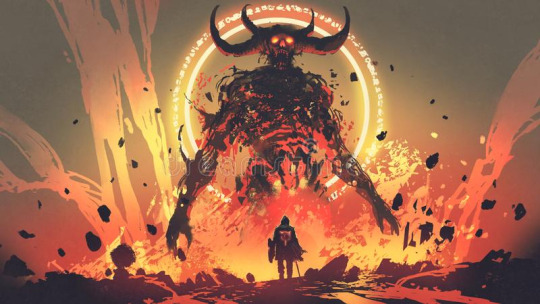
“I Will Show You”
As far as music goes, if you want to play something while reading this, I use Kefka’s theme from FFVI, Zeromous’ theme from FFIV, and the Final Lavos theme (this one) from Chrono Trigger. They are appropriate choices. A lot of this battle, and in fact the entire set up, has been inspired by both Chrono Trigger and FFVI in particular, which I think had some of the best final set ups of any JRPG ever. In FFVI Kefka wins and the party has to regather allies to face him like they do here. Chrono Trigger’s final battle takes place in time and space, which so does mine. And finally, there is the crystals that are so prevalent in early FF games (and sorely missed in more modern entries). They come into play in my design as well.
To get down to business... so I design Abenthy as a modified Solar from the Monster Manual, with some different spells that let him bring the Abyssal tentacles onto the battlefield (this is stuff like Evard’s tentacles, Shadows of Moil, Arms of Hadar) and which he can use as legendary actions in addition to a normal action. Note that the Solar is very deadly on his own, especially with his longbow:
Slaying Longbow. Ranged Weapon Attack: +13 to hit, range 120/600 ft., one target. Hit: 15 (2d8 + 6) piercing damage plus 27 (6d8) radiant damage. If the target is a creature that has 190 hit points or fewer, it must succeed on a DC 15 Constitution saving throw or die.
Holy instant kills batman. Especially with the Solar’s ability to teleport and fly, he can keep some massive distance between himself and the PCs and rain down destruction with that bow. That said, Abenthy does not start out combat using this deadly combo. Early on, he prefers to use his tentacles to suck the life from the PCs and use magic blasts to try to weaken them.
Abenthy also has four crystals floating around him, which serve to grant him different powers and which really should be targeted first in order to weaken him enough to fight. One crystal heals him every turn. Another two controls (one each) the shadowy monsters (which are themselves monsters from Tasha’s guide, beefed up versions of the Shadowspawn (pg 114, Tasha’s). This means the action economy is more balanced between the players and Abenthy, slightly skewed in his favor because of the legendary actions and the constant battlefield effects of the tentacles. Finally, the last crystal can block spells of up to 4th level, which helps mitigate Imoaza’s easy damage dealing cantrips (she is deadly with her Eldritch blasts).
Finally, there is Abenthy’s Blackrazor, which moves on its own and attacks with the same basic stats as a Solar’s Greatsword:
Greatsword. Melee Weapon Attack: +15 to hit, reaah 5 ft. , one. target. Hit: 22 (4d6 + 8) slashing damage plus 27 (6d8) radiant damage.
Sooo shit tons of damage. Blackrazor is also indestructible and invulnerable, except for one caveat... which we’ll get to later.
The final gimmick of this fight is that each round, as Abenthy takes damage, he changes the battlefield, taking the party through space and time to places that were of import to him, with his tentacles (representing the plane of Chaos) ripping these places to shreds as they fight. Basically, they are witnessing the destruction of their world as they fight, beginning with places that meant something to the players (if not necessarily these specific characters). It’s a way for me to meta-nod to our previous adventures, while also hitting us all where it hurts, right in the nostalgia feels. At the same time, it reveals more about Abenthy’s psyche and fall from grace.
So, below, I’m going to go through each place Abenthy takes them, and the general progression of combat events there (I won’t be getting action-by-action specific).
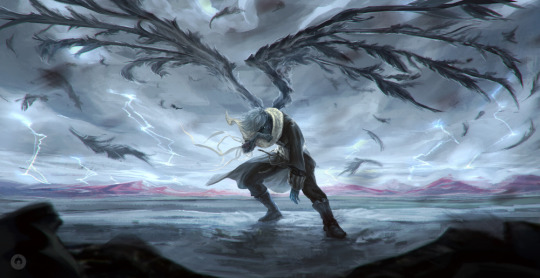
Time and Space
The opening clashes take place at Ottoman’s docks, but quickly this falls away to reveal floating space, the limbo before combat begins in earnest. This lets the combatants get off some opening salvos, test each other’s strengths and powers, and then we really dive into things, as the battlefield shifts for the first time to another memorable place.
You hurtle through space towards the planet you recognize as your own, heading at the speed of a comet through the atmosphere, coming down towards the crater of some long ago crashed meteor, heading through the earth itself to come to rest in a gigantic cavern, the epicenter which is a forgotten Yuan Ti pyramid.
Abenthy says that this is the place where an entire people proved they did not have the foresight to handle the responsibilities of caring for a world. They only sought power. And it was granted to them. They used it to destroy themselves. This is the Yuan Ti he refers to, this is their fane, Imoaza’s ancestors in particular, who worshipped the Surveyor and ultimately killed him when they felt he was giving their world to the humans he had helped raise out of primitive apes. Imoaza was last here at the end of the Red Hand campaign and it is also where our current Carrick awoke inside a clone body more recently.
The fight progresses for a time, with Milosh focusing on the shadow spirits, Imoaza trying to deal with Blackrazor, sword against sword, and Carrick rushing to fight Abenthy directly. And eventually the battlefield changes again.
The world shifts and shatters around you and the first sign of the transition is the biting cold. You find yourself standing on the edge of a ruined village, floating on an icy glacier.
Abenthy says he has seen that they themselves dare to think themselves capable of judging others, referring to the ice village that Milosh destroyed. “You have eradicated an entire village out of anger. What I do, I do out of foresight, not anger.”
Carrick gets some critical hits in this round and the PCs begin to figure out that they need to be targeting the surveyor stones floating around Abenthy. Their strategy changes, and as it does, something seems to split inside of Abenthy... his confidence changes to something more like sorrow.
Your next destination smells of brine and your ears fill with the roar of the sea as you stand aboard a wrecked seaship. Fog emanates from all around the dilapidated vessel and you can see bits of debris from its hull floating in the choppy waters. One board has the name STORM painted across it.
“Here is where she learned sorrow,” Abenthy says, and they wonder who he refers to. “Where she learned that she could not save the world. Her friends died here. The one who helped kill them she later took as lover. She never told you that, did she? Karina didn’t tell many that story. But I know it. For I know Karina, better maybe than she knows even herself.”
One of the stones, one controlling one of the shadow demons, is destroyed this round, by Milosh, while Carrick distracts Abenthy. However, this sends Abenthy into a rage and he unleashes his Bow of Slaying on Carrick, nearly taking him out of the fight completely. Carrick has to pull back to heal, and the map changes again.
This place you all recognize, for you were here but recently. It is the inside of the volcano in which Haggemoth’s tomb resides. Lava fills its chambers now, except for one high precipice on which you all find yourselves facing Abenthy.
This area ends up being the most critical of their fight. Imoaza finally realizes that Blackrazor is indestructible, but has the thought that her version of it, Blackrazor Alpha, is the promise of all that the evil sword will become. And if it never existed... the sword Alpha actually finishes this thought for her, telling her that, yes, this is the only way. And so, with her action, Imoaza throws Blackrazor Alpha into the lava flow, destroying it forever.
This is a shockingly intense moment for the player. Once she starts crying, we all do. She explains it as a huge arc for Imoaza. Blackrazor Alpha was made in part from her Drosselgreymer, the weapon she stole from her people. It represented her desire for power, her class as a Hexblade. It was her Hexblade. To destroy it all now symbolizes her letting go of that pursuit of power. It also dooms her people to being a simpler folk, for the power of their hexblades is drawn from Blackrazor, and now that is forever destroyed. This also fulfills a piece of her personal prophecy: she has let go of the artifact, and freed her fate from it.
The more evil Blackrazor lets out a mighty scream, saying that its destruction is impossible, that time has already decided it exists. But the lava of Haggemoth’s lair was imbued with his magical energy in order to destroy artifacts. What’s more, with such a powerful artifact destroyed here, the sacrifice offered to the gods is complete. The balancing of Haggemoth’s soul, so long ago disrupted by Abenthy, is finally complete. Attonement is given to the dwarf. He appears briefly, thanks the party, and finally goes to rest in the halls of his ancestors.
However, though Blackrazor is destroyed, the fight goes on. Abenthy begins to spiral back towards his old self, remembering... and as he remembers...
The roar of lava is replaced by the roar of the sea, crashing against a sandy shore. Above you looms a great cliff, at the top of which can be seen a broken pagoda. Another roar sounds, a quake shudders the island, and the pagoda begins to split apart even more.
This is the Island of the Oracle. “Here,” Abenthy says, “is the sanctum of one who could have changed things. She saw. She knew. But she choose to send me on the quest. Because she knew what needed to happen.”
As they fight here, the island continues to fall apart. The Oracle is dying, her power being drawn from the world, for she received her power from the surveyor’s stones, and Abenthy has channeled the last of that energy into this fight.
In the fight, the stones are all but destroyed now by the PCs. The last one remaining under Abenthy’s control is the one that heals him, and Carrick makes a desperate gambit to snag it out of the air and flee from Abenthy with it, getting ready to destroy it at all costs.
You are in a cool, calm place. Books and shelves surround you, as does an aura of austerity. A shield depicting a woman’s profile, her head wrapped in a laurel crown, is set in a place of honor overlooking this large library.
“And this is where it happened. This is where I met my father. He thought he knew the way. He thought he could control me. But he was wrong. He was only a lesser evil. He had failed so long ago, he had become irrelevant. I ignored him and he met his fate at the hands of the demons he fought with over power.”
Abenthy’s voice rings through the halls of the Sisters of Celaenos. And then suddenly a new voice takes over. It speaks in an arcane tongue and tentacles erupt all over the battlefield.
“Enough of this whining and melancholic tripe,” the cruel voice of Nazragul speaks, though it comes from Abenthy’s body. “I have indulged you all long enough. Now it is time to end this.”
The battle changes drastically at this point. The tentacles snatch at the party, trying to tie them to the ground, while Abenthy/Nazragul flies high into the air, far beyond their reach, and begins raining magic down on them. His blasts destroy the final crystal, but he doesn’t seem to care. He is raining destruction on the party, seeking to end them before they have a chance to recover.
Imoaza uses her last remaining injection from Roger Krisp to heal Carrick to full health. MIlosh frees everyone from the tentacles, Imoaza uses the last of her magic to cast fly on them all and they rush to reach Abenthy. They rush as the battlefield continues to shift to other places they know... Waterdeep... the ruins of Vraath Keep... and finally as they reach Abenthy and strike a grevious blow against him, it becomes a temple, darkly familiar, a temple that should destroyed.
You stare at a place you thought you would never see again, hoped to never see again. Its dark corridors have been rebuilt and blue flame flickers in torch brackets all around the rebuilt altar room of the Maakengorge temple. Where the Tarrasque once blocked the view of the abyssal chasm of the Maakengorge, now instead there is only space beyond that opening, a void without color or definition.
Nazragul sees the end coming for him and so he curses the players, telling them that there is no way for them to win here... there never was a way. He is inevitable. He is timeless. He is the death beyond the end of the world. He is the new beginning.
And as he speaks, he summons his final spell. A storm of meteors crashes through the high roof of the temple above him, fire raining down on him and the players alike, dealing hundreds of damage, utterly destroying the temple and leaving Nazragul alone, broken but regenerating, floating in space.
The players have been defeated.
Next time, the second part of this final session!
2 notes
·
View notes
Text
Part 94 Alignment May Vary: A Clashing of Fates
The Mountain loomed in the background, the mighty Jarlberg. The armies of the New Alliance, made up of a conglomeration of races from elves to ice barbarians to the common people of the Sword Coast, marched through the ice and snow, chanting battle cries to keep their spirits high. They felt a mighty army, but the sight of the Mountain caused a shiver to run through their ranks.
The Mountain seemed a god fallen to earth. Around it a black cloud swirled, and as they drew closer they could all see it was no cloud, but winged demons. Two flanks of armed foes stood on either side of the mountain, ready to flank their army. The Yuan Ti were arranged on the left, and it seemed the entire race was present. Imoaza could not see the leader, but she knew that somewhere in that mass was her son, Xaxus, whose name meant “The Serpent Who Would Eat the World.”
To the right were the Undead, a huge number of them, all the Undead that had attacked Vraath Keep, bolstered to twice that number by all those who had died in that battle. Leading them was a giant of a woman, dead as the rest, but filled with more rage. She wore a bloodstained mask, and Milosh recognized her. It was Sierra, wearing the mask that seemed to transform her into a more powerful fighter. Karina would have known the mask: it long ago had been worn by Shando to make him El Ultimo Santo.
With a mighty cry, the two armies, both made up of former friends, former foes, and even family, began to advance.
This is a massive battle. On the one side is Abenthy’s army, made up of over 6000 undead, 2300 Yuan Ti, 1000 Demons, and nearly 1000 monsters deserted from the Vraath Keep forces. They have champions, as well. Sierra, wearing the mask of El Ultimo Santo, leads her fellow undead. A Balor has been summoned from the Abyss to assist Abenthy with bringing the realm of Chaos into the physical plane. It leads the demons, all of them flying units. Xaxus leads the Yuan Ti, and there are a couple of other special units yet hidden. Directing it all is the will of the Three Who Are One, having taken Abenthy’s form. He does not seem to be present, but his power moves this armies like pawns on a board.
The New Alliance is only half the size of Abenthy’s army. Comander Feluver leads it, and has brought a contingent of 2000 wood elves. Waterdeep, followers of Karina, and Baldur’s Gate refugees add another 3000 to this number. The tribe of Ice Barbarians has helped prepare the army for fighting in the snow, while adding 55 of their own number to the fight. And finally, 15 adult dragons, three each from the metallic colors, have come to add their prodigious might to the battle.
What the Alliance lacks in numbers, it makes up in legendary heroes. Immerstal the Red is here, lending his fire magic. Verrick comes with all the power of a death knight, bound to Milosh. Breath Giver has become the leader of Watergate and wields the power of the Blackstaff. Her brother, Orcaheart, is a mighty Ice Barbarian warrior who once (as he reminds him) beat Milosh in a one-on-one combat... with a little help from his sister. Hecate is poised like a knife at the heart of the Yuan Ti, hidden among their ranks and unsuspected in her treachery. Daymos and Jade are present, not fighting, but using their psychic energy to disrupt Abenthy’s control over his army. And of course the PCs themselves: Imoaza the Yuan Ti Weave Seer and Warlock; Milosh the Half Orc Mercenary from another world, choosen by Primus himself to be a champion of order; and Carrick, human Paladin of Primus, infused with the knowledge and wisdom of the Surveyor.
The idea for this combat was inspired by Tyranny of Dragons. I never was satisfied with how the final battle in that campaign is described. The DM is just sort of left to “figure it out” and all the promise that PC actions were going to matter and have a mechanical impact are left behind. It’s a little better written in the rerelease of the campaign, but the major issue is still not resolved: no good mechanics are given to help simulate a battle of the proportions described.
So to play out this combat, I wanted to fix that problem. I turned to DMs Guild and read a number of mass combat rules, including old 1st Edition D&D rules written by Gary Gygax himself. Most did not meet muster. They were either too complex or clunky, or too nebulous.
But then I found the aptly named “Simple Mass Combat Rules” by Christopher Heatherington. As of this writing, Chris has only done one other release on DM’s Guild, but I know he’s active because he responded to my praise for his Mass Combat Rules. I want to repeat that praise here, and encourage anyone who ever wants to run a mighty army vs army battle in D&D to use these rules. They are good enough I think Wizards of the Coast should officially adopt them.
I won’t go into the details of the rules here, except to say that basically every creature in an army adds to its value, and those values are compared to figure out how much “life” each army has. The higher value army always has 20 life, and the lesser value army has life equal to a percentage of that, based on their army’s power (in this case, 15 for the New Alliance). Each round essentially comes down to two rolls. One is a commander’s roll, to compare how well each army fights. Another is a morale roll, to see if either army breaks its spirit. Affecting these rolls with pluses and minuses are the actions of the PCs, who get to direct the armies and take actions themselves in combat. The focus stays very macro, so you aren’t usually running individual combats (though you can, if you feel it is a key moment).
Below, I’ll take you through the major steps of our battle, and describe how it all plays out.
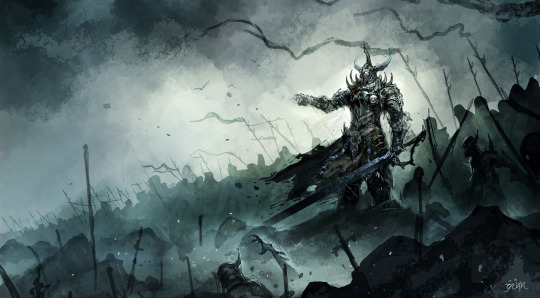
The First Clash
The Yuan Ti army stays where it is, but the Undead march forward to meet the New Alliance. The PCs work to come up with a plan of attack with Breath Giver and Comander Feluver. They decide to send the Waterdhavians charging against the Yuan Ti, while the Elves and the rest of the Alliance will try to destroy the Undead. Verrick and Orcaheart are assigned the task of taking down Sierra, which they grimly (Verrick) and excitedly (Orcaheart) accept. Immerstal and Milosh lead the charge against the rest of the undead, keeping the troops in line and their morale high. Carrick hangs back with Breathgiver, assisting as medics on the field.
The first clash against the undead El Ultimo Santo has all the intensity of a raging inferno. A circle in the middle of the armies is formed, as even the fearless undead pull away from the raw destructive power of the battle. El Santo is a beast of pure reckless force, crater the icy ground with each blow of her maul like fists. Verrick wields all the unholy might of a Death Knight, and brings it against Santo, sending waves of necrotic energy spiraling around them, refreezing the slush that their boots make of the arena. Faced with such power, it is impressive that Orcaheart shows no fear and holds his own ground, picking the perfect moments to move in and strike against El Ultimo, while she is distracted by Verrick’s furious blows. After a half hour of fighting, the three are still locked in deadly combat.
Meanwhile, the Waterdhavians advance upon the Yuan Ti, but this seems to have been predicted by the clever snake people. They send hails of arrows and blasts of powerful magic raining down on the hapless army. Still, the Waterdhavians charge, seemingly into a suicide run.
However, there is a method to this. The distraction caused by their rush has allowed one very special person to leave the main army and travel undetected across the snow at high speed, using her mastery of the weave to disguise her presence. Invisible, Imoaza steals across the ice, until she is behind the Yuan Ti army. Then, dropping her spell, she assumes the appearance of a non-descript Yuan Ti warrior and blends in with the mighty army, seeking her son, and vengeance.
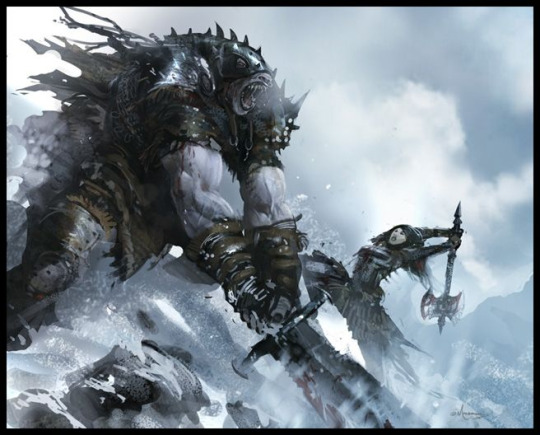
Mortal Combat
With battle broken upon the two armies, Abenthy seizes the advantage early on. The Waterdhavians are getting crushed under the ranged might of the Yuant ti and their magic. Imoaza has merged with the Yuan Ti army, but pressing through to find Xaxus is like trying to dig through solid rock with your fingernails. The Yuan Ti stand tightly packed and are observant of anything breaking the order. Imoaza has to be careful, but she also needs to be quick: the Waterdhavians are suffering more death every second. Each moment she delays is a moment of failure.
While Imoaza seeks to complete her secret mission, Abenthy moves two assets into position on the field. The demons break off from their perches on the mountaintop and fly towards the main Alliance army, seeking to rain fire and death upon it. They are met mid air by the Allied Dragons, who tear through the demons with mighty blasts of their breath weapons and flashes of claw and tooth. A group of the demons breaks away and lands at the back of the Alliance, led by the leader of the demons, a mighty Balor known only as The Forgotten Death. Milosh and Carrick and Breathgiver come together to lead the rear defense, but the undead are closing in from the front. Immerstal adds his mighty magic to the fray as well.
While all this is going on, Abenthy send his second asset into the field on a secret mission of its own. It is a mighty Dracolich, and it soars silently towards the Alliance headquarters, where it hopes to find the source of the psychic power holding him back: Daymos and Jade. It will easily eliminate the two distracted psychics.
But before it can reach its goal, a mighty roar of sadness splits the sky as the Bronze Dragon Argent, the PC’s companion and mount since the adventure on the Moving Ice, spots the Dracolich and recognizes its essence. It is his mother, the Bronze Dragon Sauros, who so long ago promised aid to Karina and was eventually slain by the Red Hand. Argent, wailing with sorrow, turns from the battle against the demons and flies at his mother, determined to end her suffering. The two dragons clash mid air and begin a deadly, sorrowful dance.
In the midst of these developments, Verrick and Orcaheart finally deliver the killing blow to El Ultimate Santo, though Orcaheart takes a mighty blow, crushing his lower spine, to leave the great beast open. Verrick kills Santo and as he falls, his mask splits in two and Sierra, her undead body broken, is released from his hold over her soul. Santo makes one last statement: “Finally, El Ultimo Santo may go to his rest.” Then the mask falls into dust and soon is lost amidst the snow. Both Sierra and the long suffering soul of El Santo find their rest.
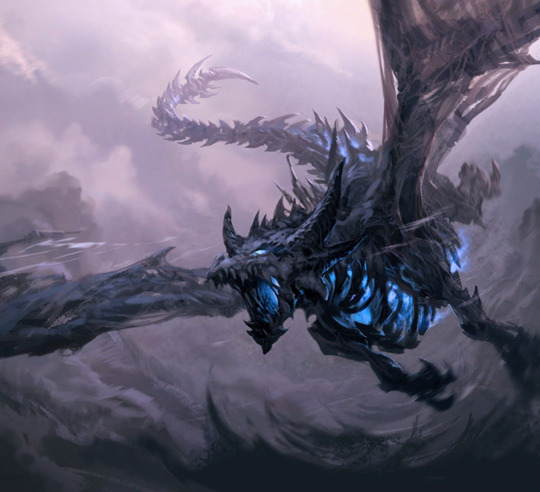
Desperate Measures
With El Ultimo slain, Carrick and Milosh realize they have to press their advantage. However, the undead have no fear. The death of their greatest warrior does nothing except leave them free to attack the ailing Verrick and the downed Orcaheart. MIlosh pulls the two out of the conflict and gets them to safety, fighting off hordes of the undead to break through to the Alliance camp.
“Brother!” Breathgiver ran out of a large pavilion as the soldiers carried the limp form of Orcaheart into the camp. She rushed to his side and took his huge hand in her tiny one.
“Sister,” Orcaheart said, his voice thick with pain. “I have fought the battle of my lifetime and I fear it is to be my last. Do not cry, you need to be a leader now. You are the Blackstaff.”
“I am also still your sister,” she said, angrily wiping the tears from her face. “And it is not your time. There is still work to be done.”
Breathgiver summoned her powers and laid her hands upon Orcaheart. He gasped as the pain was torn from him, as wounds closed and bones mended. He moved his legs slightly. Breathgiver bent and kissed him on the forehead.
“Your fighting days are over,” she said. “That much is true. You will walk, but stiffly, and will never be able to match another in combat as you once did. But there is more to life than fighting, brother. When this battle is over, peace will reign, and I will need your strength by my side to help me rule.”
Orcaheart looked at Milosh, who had dragged him from the fight. “Go,” he said. “You are the only one to have ever defeated Orcaheart in a fight. Now your friend needs your sword arm at his side. Alas, my sister speaks wisdom. I can do no more for you in this battle.”
While this is happening, Carrick is still behind in the mass of swelling undead and Milosh plunges back into the fray to try to reach him, Verrick following him as his bound companion. The three end up separated, fending off wave after wave of the undead, slowly losing their own fighters to the horde. Finally they all end up reunited, back to back, each covered in the blood of the slain.
“They are growing in numbers!” Carrick calls out.
“Our own allies are swelling their ranks,” Milosh answers.
But that isn’t all of it. Carrick reaches out with his divine granted senses and realizes that the army is being restocked continuously by a host of corpse flowers, the disgusting plant like undead that destroyed the Witchwood. He tells Milosh of his discovery, and the two realize that they must take what remains of their army and do everything they can to reach and destroy the Corpse Flowers.
“I will make an opening for you,” Verrick says, and plunges into the middle of the horde.
Milosh looks up and sees dragons falling from the sky, their wings burned to a crisp. The demons screech insanely.
“We are out of time,” Milosh says.
While all this is going on, finally Imoaza finds what she is looking for. Xaxus sits upon a palanquin set astride a mighty Tyranasaur-like creature, long bodied and long tailed, with a face mostly made up of teeth. At his side stands Hecate, seeming completely subservient.
Imoaza thinks fast. “A message from the front,” she cried out, getting Xaxus’ notice. “The One who is Three sends new orders.” Xaxus ushers Imoaza, not recognizing her in her disguise, up onto his platform to give him the news directly. Hecate’s eyes widen, and Imoaza realizes that she, somehow, has realized who she is.
“What is the message?” Xaxus asks.
Imoaza leans close. "Thank you for bringing me my army."
For a moment, she drops the disguise. Xaxus’ face pales as he recognizes his long lost mother. But before he can react, Hecate blasts him in the back with her gun arm and Imoaza summons Black Razor Alpha to her, and stabs deep into Xaxus’ heart.
Around them the Yuan Ti go silent, staring up at the sacreligious murder of their mortal deity, the Serpent Who Will Swallow the World.
“What now?” Hecate asks.
“Now we see if the Yuan Ti believed your prophecy about the dragons.”
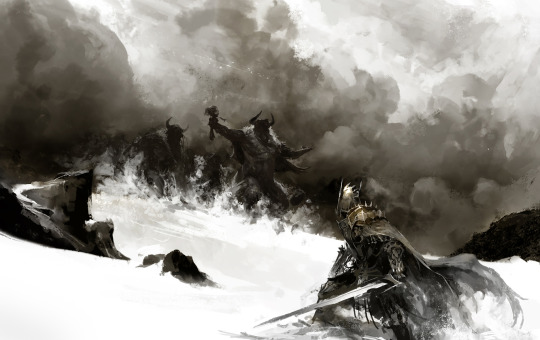
When All Else Fails
Imoaza stood in front of the full might of the Yuan Ti army. They stared at her and she felt suddenly that she teetered on the edge of a precipice, not a physical chasm, but an edge of time. On one edge, she saw the Yuan Ti throwing themselves like rabid animals against the forces of the Alliance, destroying many of the citizens of Waterdeep, so many dead that the snow turned red with the blood of humans, dwarves, and elves. The Yuan Ti were killed to the last one, the race ended in their rush to meet Dendar the Night Serpant.
That was one path. The Yuan Ti would be forever remembered by history as a powerful race, one which had fought to the bitter end, one which had never been conquered.
One that never thrived again.
The other path showed the Yuan Ti as a peaceful race, peaceful and simple. They were not rulers. They did not conquer or seek power. History forgot them. But they survived. They worshipped the path of the metallic dragons, sought balance in life, and sustainability in living it. They surrendered their armaments and faded into the background of civilization.
And they survived.
Imoaza looked out over the crowd of Yuan Ti watching her and for a moment doubted herself, wondering how she could possibly ever convince the Yuan Ti to be a peaceful people. Then she felt a hand on her shoulder, and turned her head to see Hecate giving her a slight nod of support. She remembered her daughter as she had been, the most bloodthirsty Yuan Ti of all, chasing her across the very planes of existence. If she had changed, had found peace, then so could her race.
Imoaza turned back to the crowds, raised her hands and magnified her voice, and began to speak.
Many things happen on the battlefield.
Argent and his undead mother, Sauros, let out a mighty roar as their battle ends, the two dragons peeling away from each other, trailing blood in the sky, as they fall behind the mountain and are lost to sight. We make a roll for Argent, a die roll to see if he survives.... which I’ll reveal at the end of the post.
And the Balor, the Forgotten Death, lands in the midst of the Alliance army, seemingly invincible, and begins carving a path to its leaders, Breathgiver and Feluver. Immerstal pulls on his last resources to hold the Legendary Demon General at bay. Do they survive? It will come down to a roll....
Verrick rushes into the the center of the undead army, where he unleashes his final attack. It is a powerful blast of fire that tears out of him, ripping out of every pore of his body and blasting the undead around him into smithereens. He thinks of Karina as he unleashes his power. We make a die roll for him, too...
Regardless, MIlosh and Carrick know there is only one chance they will get to have this advantage, and they lead a desperate charge through the hole Verrick has made. But already Abenthy is reacting, using all his willpower to draw the undead into an impenetrable line in front of the corpse flowers, knowing that while they exist, he cannot lose this battle. Milosh looks to Carrick as they charge and thinks of sacrifices.
“I’m sorry,” he says, and unleashes a divine blast, a power given to him by the Inevitable, the power that is prophecied to be able to strike down Primus himself. It rushes out of him, and many of their own soldiers die in the blast as it expands out to 60 feet. It tears through the final stand of the Undead. It washes over Carrick, bringing him to his knees... but Carrick stands again, and together with Milosh, they rush the Corpse Flowers, and begin cutting them down.
This is the turning point in the battle. With the Corpse Flowers cut down, the Yuan Ti army in confusion, and the demons outnumbered by the dragons and the remaining alliance, it seems that the heroes have won through!
But Abenthy has only been stalling for time.
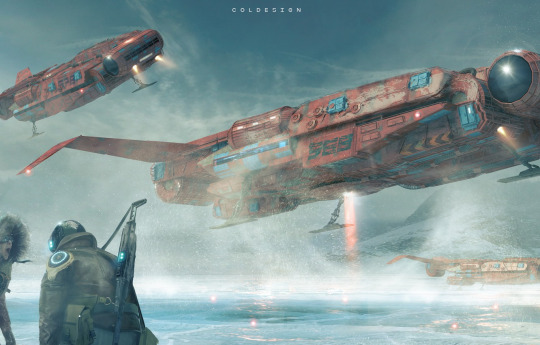
From Above
A roar froze everyone in the midst of battle, causing even the Balor to pause mid strike, and turn towards the mountain. Tentacles were erupting all over the mountainside, ripping through space. And emerging...
... no, thought Carrick, covered in the stench-ridden blood of the corpse flowers. No, we have come too far to fail now.
But failed they had, for the battle had only all been a delay, a tactic designed to weaken them in time to summon forth the Tarrasque.
And not just the Tarrasque. Even as the great beast emerged from the portal being ripped in the side of the Jarlberg, the clouded skies split open and a rumble rolled across the battlefield.
Carrick knew what was coming. Abenthy himself was entering the battlefield. Given the power of a god, he was coming to smite those who had been foolish enough to defy him. Carrick fell to his knees, feeling hopelessness wash over him, as the god’s voice split through the sky.
But it was not Abenthy’s voice. It was a battlecry:
“FOR ALDRIC, AND THE GREEN COMPANY!”
Carrick raised his eyes once more skyward, in time to see, not a god coming to smite them, but ships. Dozens of ships, breaking through the atmosphere. And, at their head, one mighty vessel which looked remarkably familiar. The surveyor’s ship, which had taken them across the planets and into the very Abyss itself. It had once been unnamed, but now bright gold letters crossed its hull, spelling out a name Aldric would have been proud of: The Anope.
(DMs note: for those who have forgotten, which is probably everyone except my players, Anope was Aldric’s horse back when he first joined the party)
Then a very familiar voice came cascading over the battlefield:
“Seem to be in a tight spot, gentlemen!” came the cry of Roger Krisp, “What you need is a little help and maybe some of my patented cereal! Captain Krispies! Sure to put a pep in your step! And it comes with prizes. And today, that prize is anti-armor bombardment! Cover your butts!”
And as he spoke, the ships opened fire, launching enough missiles, energy blasts, lasers, and bombs to destroy the rest of Abenthy’s army and even finally take down the Tarrasque.
Who lives? Who dies? I said I’d say at the end of the post, but I maybe kinda sorta lied. I’ll share next time, though, when I’ll also share our final battle against Abenthy, which takes place in a very strange and unique battlefield, and we reach the long awaited conclusion to our campaign.
Thank you so so much for reading this far. We’ll see you at the finish line.
4 notes
·
View notes
Text
Part 93 Alignment May Vary: A Series of Side Quests
ALast time, I introduced the concept of how I’m handling the pre-final battle side quests, which will influence how that battle goes. I’m taking a lot of direction from the RPG Blades in the Dark for this, which I highly recommend as a must-read for any DM who wants to take their game to the next level. Even if you don’t end up playing Blades in the Dark, the way it presents how to run a satisfying game and how to keep your sessions focused on actions, obstacles, and consequences, is incredible reading. For these side quests, I’ve really drawn on its lessons a lot in order to keep the action focused and our story moving. If I didn’t, the five missions I’m going to cover in this post could have taken us months to play, as we explored dungeons, fought various combats, and had downtime between each quest. As it is, we do all five of these (plus the one from the last blog post) in a single large, six hour session. In that time, the players roll a ton of dice, but we don’t run a single combat... though they overcome many many obstacles along the way.
Here, then, is a brief rundown of each of our little “side quests.” This is a long post, so enjoy!
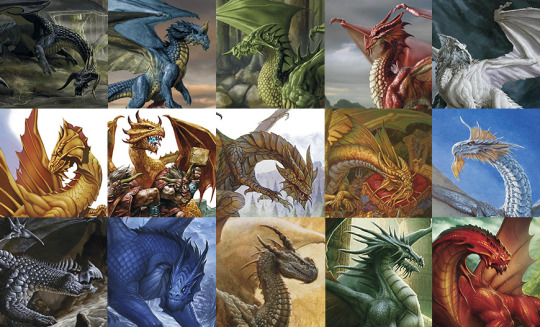
Dragonmeet
Argent, their bronze dragon ally, tells the PCs that they need the support of the dragon council if they are to fend off Abenthy. The PCs agree.
The journey from Waterdeep to the Nether Mountains is more than six hundred miles. For three days, Argent flies you north, passing overhead many signs of ruined cities and villages. No people remain, but neither is their undead or monsters. Abenthy’s influence is silently spreading, and as it does, it is erasing this world of life, leaving nothing behind.
Arriving at the Nether mountains, the PCs are given audience by the council of the great Metalic Dragons. This is a scenario lifted out of Tyranny of Dragons, in a nod to our original planned adventure, four years ago. But whereas in that campaign, there are specific things each dragon wants, here I leave the direction of the conversation more up to the PCs. All three of them make a plea, roleplaying out the conversation, with me playing the dragons. Milosh focuses on his life in Eberron, and the fact that dragons have disappeared from his world and their guidance is greatly missed. He fears Abenthy would see everything destroyed, them included. Carrick compares the dragons to Primus, in their greatness and glory, and says that in a way people are their creations and begs them to make the decision to protect life. Imoaza’s plea is full of regret for the path her people, the Yuan Ti, choose to follow, and says that the dragons are right to judge people not worth saving in the past. But she promises that if they are saved, she will make the effort worth it in the future.
These pleas move the dragons, and they agree to give aid, on one condition: that when the war is over, the Yuan Ti turn to worship of them, and follow a better path.
Imoaza agrees to do this, if she can wrest her people free of their current leader, her son, Xaxus.
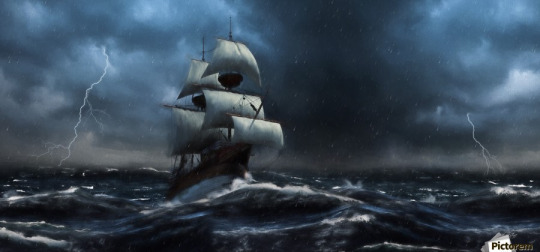
An Icy Reception
The PCs decide they need the assistance of the Ice Barbarians in order to fight successfully in the frozen plains of Friezurazov. Also, they will not abandon them to slavery, which which be their fate if the PCs do not intervene.
Argent flies you across the Moon Sea, until you come across a line of Prison Ships. The moon shines down upon them, and upon the head ship, named The Re-Enlightenment, and captained by Gregor Tolman, whose great grandfather once captained The Enlightenment, lost at sea ages ago when it fell befoul of a plot involving the Red Hand. Among its final passengers were Shando, Daymos, and Karina...
The roll to set this quest up goes really well, so I actually cut out an encounter I had planned with the Tarasque, summoned into the ocean by Abenthy to destroy the Barbarians before the players can recruit them. Instead, the PCs reach the ships before Abenthy realizes they are going after the Barbarians, and so this encounter comes down to another roleplay moment, with the PCs having to convince Gregor Tolman to give over the Barbarians to their care.
To do this, I really enjoy the plan the players come up with. Imoaza poses as a haughty noble who says she represents Nakir, their noble ally from Waterdepp, and says he wishes to buy the slaves... all of them! With the help of some magic and good persuasion rolls, they convince the captain to turn the ships around and drop the Barbarians off at the old sea elf post, then go back to their sailing. Gregor is a little suspicious, but they play upon his fears of nobility and convince him not to get wrapped up in their political games. Believing he is in over his head, he follows orders and leaves.
The Ice Barbarians are secreted away in the forests around Waterdeep. Orcaheart, in particular, is overjoyed to have the chance to fight again alongside Milosh and promises that their final drive against Abenthy will “shake the very heavens.”
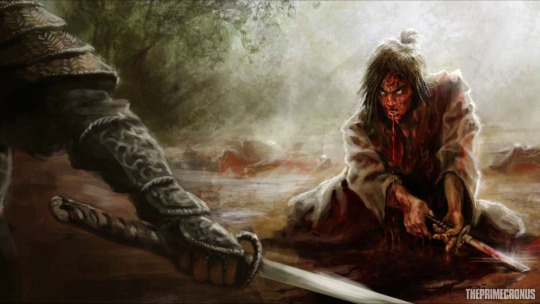
Death Pact
One character that the players are very concerned about is Verrick, the four-eyed Tiefling and former lover of Karina. He is a long long term NPC, and so the players have a personal connection to him. Also, he has become a Death Knight, under the control of Nazragul. While that control seemed to be broken at the Maakengorge, the news that he may be returning to Abenthy’s side is a concerning notion, as he is quite a deadly foe.
You catch up to Verrick at the ruins of Baldur’s Gate, where you find him sitting on a fallen statue, head in his hands. He looks up wildly as you approach and gets to his feet, waving a hand at you as if to push you away.
“Stay back,” he warns. “I do not know how much longer I have control of myself and I would not want to hurt friends of Karina’s.”
It is easy to convince Verrick to fight against Abenthy, but the problem is that Verrick is magically bound to Nazragul’s soul, and has a deep connection to Karina and Abenthy as well. With the three combined in one body, he is finding himself drawn back to fight for him.
Verrick says that, as a Death Knight, he is doomed to be bound to another’s soul until such time as all bounds are broken. Even death cannot stop him while his binder lives, he says. But if they can defeat him now, he will not reform for some time, and will not be able to fight against them in Friezurazov. He prepares to duel them...
... but the PCs have other ideas! I really like how the PCs solve this one. Milosh decides to try and unbind Verrick’s soul from Nazragul and bind it, instead, to himself, thus meeting the requirements of the Death Knight’s contract, while actually winning him over to their side for the final battle!
It requires Imoaza’s mastery of the weave to pull off, and carries a significant risk of killing Milosh, but in the end the players manage to roll through it, and Verrick’s soul, while not freed, is at least bound to the force he wishes to fight alongside.
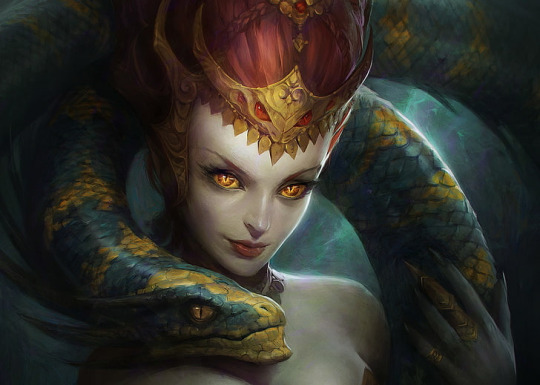
The Wayward Daughter
This is a tricky one. Imoaza receives word that Hecate is being held at Spiral Tower, an underground fortress where the Yuan Ti torture and brainwash those who have “left the fold.” Hecate’s treachery has been discovered, and she is about to go through a re-education program to make her, once and for all, a thrall of her brother, Xaxus.
Imoaza’s thoughts turned to the daughter whom she had abandoned so many years ago, and who had spent so long trying to kill her. Their reconciliation on the Abyssal plane had changed both of them and Imoaza felt that if she did not save her daughter from the clutches of the Yuan Ti now, they would be forced to face each other one final time on the battlefield, and this time one would not walk away.
This mission goes wrong from the start. A bad set up roll means I actually add in an extra challenge. Argent is flying them to Spiral Tower when he is spotted by the magical sensors of the Yuan Ti. A magical storm immediately forms to swallow the dragon and Argent has to abandon the mission. The PCs use the fly spell to drop from his back, fly through the storm, and land in the forest that grows above Spiral Tower.
They waste no time in quickly preparing their plan. This is a bit of a heist mission, involving teleportation magic. Carrick and Imoaza are going to be teleported by Milosh to a precise location in the tower, where Hecate is being held, and then try to get her out. Anyone who knows teleportation rules knows there is a huge risk here: Milosh has never seen the inside of the tower, and is forced to operate off of what Imoaza can describe to him. This leads to some tense rolls, which could result in an instant death scenario for the PCs if they fail. They do not fail, however, and Carrick and Imoaza reach Hecate’s chamber via portal.
Their time is short. Carrick begins dispelling the magic that is rewriting Hecate’s personality and thankfully the process is not far enough along to have changed her, yet. Hecate comes up with a daring plan. Rather than leave with Imoaza, she suggests that she stay behind and pretend to have been indoctrinated. Then, when the moment is right, in the final battle she will turn and strike Xaxus down.
Imoaza agrees, and tells Hecate, too, of her plan to join the Yuan Ti to the worship of the dragons. She says to start spreading the word of the dragons through the Yuan Ti as subtly as Hecate can, so that the Yuan Ti begin to believe the Dragons are their true saviors. Her hope is that when the dragons arrive on the battlefield, it throws the Yuan Ti forces into disarray and opens up a path to Xaxus.
Imoaza half expects Hecate to question this new direction for the Yuan Ti, but Hecate says that Imoaza will always be her leader and will be trusted in all things. Then she tells them to go, before Milosh is discovered. As they leave through the portal, Imoaza finds herself concerned for the first time in her life with the safety of a family member, and finds the emotion both beautiful and strange.
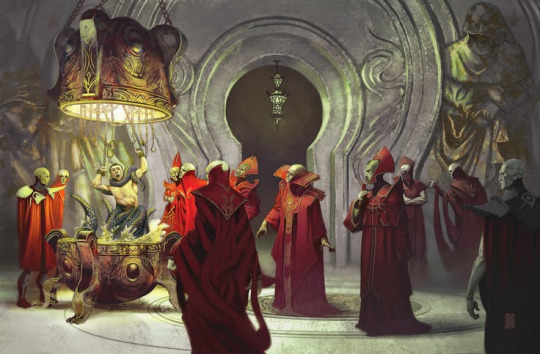
The Wizards of Thay
The final side quest involves finding Daymos and helping him recover Jade’s soul. The roll on this one is not great, and so the PCs find no trace of the psychic-turned Quasit. However, they do learn that Jade, as a Lich, had a phylactery, and that she was aided in making it by the Red Wizards of Thay. Nazragul forced her into this path so that he could more easily take over her body and make use of it, and the Red Wizards were only too happy to help in exchange for some of his knowledge and power.
When Nazragul was exorcised from Jade’s body, she died, but her soul went to her phylactery, while Nazragul merged with Abenthy and Karina. That phylactery is now with the Red Wizards.
Thay is an isolated and arid windswept plateau some twenty-five hundred miles east of Waterdeep, its dark skies constantly clouded by volcanic ash. This land is defined by the prevalence of undead within its borders. The supreme leader of Thay is the lich Szass Tam, whose council of advisers-the zulkirs-are powerful liches themselves. Everyone of consequence in Thay is a spellcaster, and necromancers are common there. Undead servants are everywhere, and many of the commanders in Thay's armies are the free-thinking undead soldiers.
This is another scenario lifted more or less from Tyranny of Dragons, though it is a little simpler than presented there. Rather than have to win over the Red Wizards, the PCs simply have to offer them something that is worth the return of Jade’s soul. The PCs also learn that the Red Wizards are holding Daymos captive, for he came to them and tried to force them to release Jade. The PCs end up negotiating for both of their souls. The price ends up being twofold. One, they must stay the night in Thay. This seems like an odd request, but the PCs agree to it tentatively. Two, they must give them an item of great power.
At first, the party thinks that what they should give over are spells of Haggemoth. However, while a tempting appetizer, the Thay wizards say that it is not enough. So the PCs keep the spells and look for something else. That is when Milosh suggests, though not without sadness, that they give up Lhu-Ee, the painting gnome that Haggemoth created, and who has traveled with them since the tomb.
It is an acceptable trade: the Thay wizards are fascinated by the notion of what is essentially a living, thinking phylactery. It is a surprisingly sad moment for the -players. Though Lhu-Ee has barely had a roll in the campaign, I played him with a lot of personality, and the players felt good about saving him from Haggemoth’s lair and from the Mummer. He made a bigger impression than I thought he would and so the moment becomes a solemn one as they hand him over to the wizards. The wizards say they will begin work on the brother and sister immediately, and Lhu-Ee bids the PCs farewell, saying that no matter what happens next, he will always love them for having given him freedom, even if it couldn’t last.
Only that night does the first gift the wizards ask for really show its purpose. As the PCs fall into a deep sleep, the wizards try to infiltrate their minds and draw forth the secrets they harbor. They are powerful secrets: Imoaza is a master of the weave. Carrick has all the knowledge of the Surveyor. Milosh is from another world. They come close to cracking Milosh, who has more self doubt than the others and is really struggling with what his purpose in life should be, but ultimately all the PCs fight them off through willpower and good roleplaying, and none of them remember the night’s events afterwards. The wizards may be sneaky, but they are not necessarily dishonorable. They recognize that they had their chance to garner secrets from the PCs and it is their own faults they failed. So they consider the deal done and turn over Daymos and Jade, their bodies restored.
The brother and sister, who have been in this campaign since it’s very first session, shed tears and greet the PCs like family, saying that they will lend their phenomenal powers to winning this war. Daymos also has one more surprise: to rebuild his body, the wizards had to put someone else in the Quasit. They choose Reeves Sar Testain, whose soul had been carried with Daymos from the Abyss, ever since Esheballa’s game. So now Daymos and Jade also travel with the reborn Testain, in Quasit form.
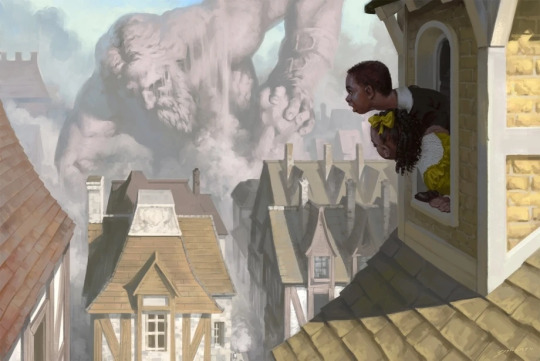
The Siege of Waterdeep
The side quests are ended, but there is one final event before the last battle. The PCs are called back to Waterdeep by Nakir, who says that it is time to reveal the Blackstaff. They all travel with Breathgiver and the real Blackstaff to the middle of the city, where Nakir has asked several of the Lords and many citizens to gather, on the pretense of a grand announcement. However, before they can make their announcement, diaster strikes. Vindass Lanteral crashes the gathering with the army of Waterdeep and says he has come to arrest Nakir and the PCs as traitors. The PCs prepare to face him down, when alarms break out all over the city. A great beast is emerging from the harbor. It is the Tarrasque, and it comes to bring Abenthy’s wrath to the city.
This is a big battle scene, with a lot going on. Breathgiver tells everyone that she can defend the city with the Blackstaff, but they must protect her. So Imoaza, Carrick, and Milosh stand guard while familiar ethereal tentacles erupt all over the city, sucking the life from its citizens. Breathgiver enters a trance and everyone hears a loud crash coming from all over the city.
Waterdeep, one of the wonders of the civilized world, contains wonders of its own. Undermountain, the Tower of Light... many argue for fun over what the wonders truly are. But the oldest citizens of Waterdeep say there are eight wonders, and all of them are statues. The Walking Statues are behemoth statues, said to have appeared out of the ethereal plane as guardians for Waterdeep, controllable only by he or she who wields the blackstaff.
Since I first read about Waterdeep as a child, I’ve wanted to do something with the Walking Statues. Now I get my chance. Breathgiver awakens the statues and I give the players control of three of them, as the Tarasque emerges like Godzilla from the docks and begins wreaking havoc on the city. Three statues converge on it and the players get to have what is essentially a giant Mech fight. The Hawkman, the Swordmaiden, and the Godcatcher all come forward to face the Tarasque and protect Waterdeep. This becomes a tremendous fight, with the Tarasque laying into the statues and bringing down the Hawkman and the Swordmaiden before the Godcatcher grabs it by the tail and, much like Mario swinging Bowser in Mario 64, spins the Tarasque through several buildings and out to sea, where it crashes into a nearby island and falls, unconscious into the ocean.
While all this has been going on, Milosh has been pulled into the Ehtereal world by the tentacles. Imoaza tries to grab him out, but she fails and is left with severely burned arms, that will remain black for the rest of her life. Desperately, Milosh calls upon his powers to teleport him back to the city... only, he doesn’t quite make it.
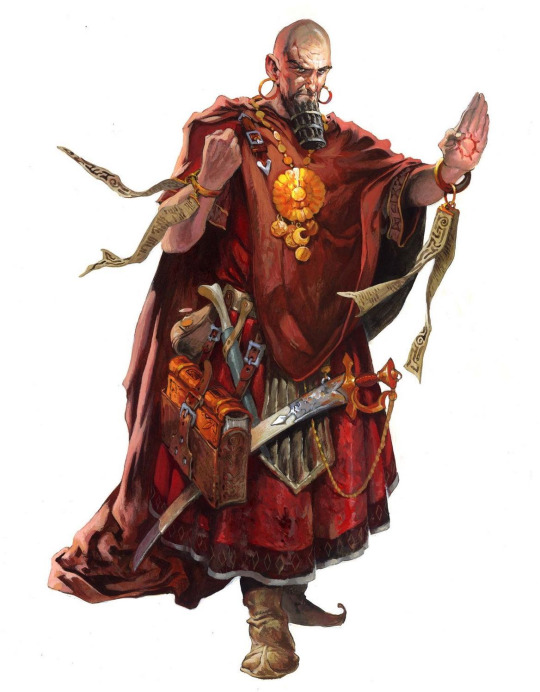
A Pocket Dimension
Milosh finds himself in, of all places, a brothel. It is being run by a strange man wearing all red, who is shocked, but not unhappy to have a customer. A few questions later, the group realizes this is Immerstal the Red, old party buddy of Aldric, who the group last saw on board the Surveyor’s ship, before he was sucked back into his pocket brothel.
Honestly, this scene is totally unplanned. I didn’t think Milosh would end up in the Ethereal but once he was there, someone (I can’t recall who had the idea, myself or one of the players) mentions our old NPC, Immerstal the Red, and it just was too perfect to not bring him back into the game.
Immerstal reveals he knew Aldric, and is shocked and saddened to hear of his passing. But he doesn’t seem that interested in returning to Faerun. Things are simpler in his pocket brothel, after all, and he is not sure it is wise to bring himself back to a world which, by all accounts, is about to be eradicated.
"Anyway,” he says, “they should just throw Immerstal’s old Fireball spells at the brute. That will show him.”
“The what now?” Milosh asks.
Immerstal blinks in surprise. “You haven’t heard of Immerstal’s mighty Fireblast?”
It turns out there’s a lot of Immerstal stuff that people haven’t heard of, or have forgotten. Sensing a weakness, Milosh plays this up, saying it’s too bad Immerstal won’t be coming back to remind the world who he was. Too bad history will forget him. This finally pushes Immerstal over the edge and he begins packing a bag, and pulls Milosh with him through a portal back to Waterdeep.
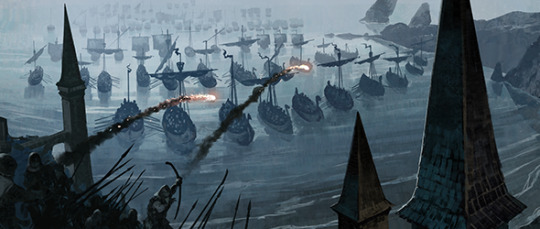
Wrapping up Waterdeep
A few final things wrap up our time in Waterdeep and prepare us for the final two sessions of our RPG. In the days that follow, It is revealed that Vindass Lanteral has fled the city, his fake Blackstaff broken. He is out of our game, and never does make a reappearance, at least not in our tales.
With the former blackstaff fled, Waterdeep is in political confusion, but they rally around Breathgiver, the new and true Blackstaff. She immediately declares an end to the shadow lords of Waterdeep and says that from now on, Waterdeep will no longer have lords, but instead shall be led by a council of people from every walk of life, and the Blackstaff shall preside over the council with the wisdom of all its ancient holders. Even as she proclaims this, word comes from the city gates that the other members of the Alliance, including the refugees from Baldur’s Gate, have heard of the Tarasque’s defeat and have arrived to offer their strength in the fight to come.
There is not much time to celebrate or rebuild. The PCs need to get to Friezurazov and face Abenthy before he can revive the Tarasque. However, in the Tarasque’s attack, Waterdeep’s massive fleet was all but destroyed, and the PCs have only Argent to carry them to battle. The armies of Waterdeep cannot follow. It is a devastating blow, for alone they cannot hope to survive and bypass Abenthy’s army.
But then hope arrives from an entirely unlooked for place. A fleet of elven ships is spotted on the horizon. When they land, it is revealed to be the fleet of the Wood Elves of the Sword Coast, led by an old elf named Feluver. He is the brother of Trakki, our PC from many campaigns ago, who was lost during the Red Hand saga. Feluver says that for the first time in many years he had a prophetic dream, and in it Trakki told him to sail his ships to Waterdeep and prepare to fight that evil which had corrupted Trakki’s soul before he passed.
This, then, is the answer to how the armies will make it to Friezurazov, how they will bring the strength to stand against Abenthy, his undead and Yuan Ti, and whatever other defenses he has. This, then, is the true beginning of the end.
Next time, our penultimate session, A Clashing of Fates.
#Immerstal the Red#DND 5e#Campaign Journal#Alignment May Vary#Karina#Waterdeep#Statues of Waterdeep#Blackstaff#Tyranny of Dragons#Dungeons & Dragons#Yuan Ti
1 note
·
View note
Text
Part 92 Alignment May Vary: The Gathering of the Storm
We last left the gamers in a precarious position... one of them, Milosh, was literally inside the mouth of a Tarasque, under the control of Abenthy, and sent to stop the players from recovering anything that could disrupt his plans! What are those plans? The merger of the material plane with the Abyss, an act that will destroy the planes and bring an end to life as we know it.
Milosh, with a strength that’s impossible to comprehend, holds open the jaws of the Tarasque for just long enough to unleash a blast of magic down the beast’s gullet. The resultant belch of flame blasts him out of the jaws and through the air, just as they hear a roar approaching them from beyond the lava pit at the edge of their battlefield. Argent, their friendly bronze dragon ally, flies in through the lava pit and tells them to get on his back. Breath Giver is with him, and Argent tells them that Breath Giver seemed to know that Milosh was in danger and was able to lead him to their location.
“The soul of Haggemoth may finally be at rest,” he tells them, fleeing away from the Tarasque, flying back out of the lava tunnel towards the beaches of Rori Rama. “His power has finally faded from this island, and no longer am I restricted from entering the sanctum. Good thing, or else I would not have been able to come to your rescue!”
They leave the island behind then, the distant roar of the Tarasque like the sound of the mountain itself groaning.
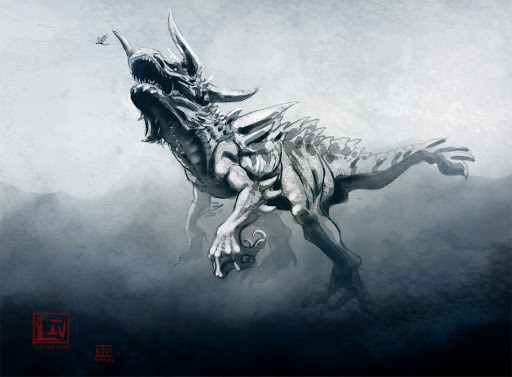
Back to Waterdeep
Imoaza and Carrick sat alone in a tent, set in the woods a mile or two outside of Waterdeep. Or rather, they felt they were alone. Breath Giver was there, too, but the silent shaman had a way of becoming invisible... not truly, not magically, but you would forget she was there. She blended in with her own silence, wearing it like a shroud.
Milosh, Argent, and Lhu Ee had gone south to investigate a rumor, one they all hoped was not true. Carrick’s mind was not on them, however. He thought instead of something Milosh had told him, when they’d last left Waterdeep.
“Have you asked Imoaza about Aldric?” he’d said, deep in his own melancholic anger. “She murdered him, you know. You would put your trust in us? In her?”
Carrick watched Imoaza now and considered the question. They were coming to the end, he could feel it. They were coming to the time when they needed to be past regrets, past betrayal, past questioning.
He cleared his throat to get Imoaza’s attention. She looked up from the book she was reading, and stared at him, waiting.
Carrick and Imoaza go into a discussion of Aldric’s death. Imoaza no longer connects with the person she was when she murdered Aldric, but neither does she regret it. She tells him that the person she was then wanted power. He asks her what the person she is now wants. She doesn’t know.
They are interrupted by Milosh returning. He says that the rumors are true: Baldur's Gate has been utterly destroyed. Argent, in the form of a black skinned human, says the level of destruction was like "the anger of a hundred dragons." Lhu-Ee says that it was the Tarasque, the great Abyssal beast that Abenthy controls. It is only a matter of time before Abenthy sends the beast against Waterdeep. "When he does though, we also have an opportunity!" the gnome in the painting cried out. “It takes power to transport such a great beast through the Abyss, and when it has been used to attack Waterdeep, we will have a window of freedom from it in which to strike at his base at Friezurazov.”
"What about defending Waterdeep?" Argent asks. Lhu Ee seems to think this is impossible, but Argent reminds them all of a letter they received when they arrived at Waterdeep. Their arrival was not met with celebration by the lords of the city. In fact, they found the city gates barred, their allies who had been in the city banished, or imprisoned, and the lords of the city telling them they would not be welcome there, and that Waterdeep was not going to take part in their war, that Baldur’s Gate had been punished as a warning to others who might think to help fight against Abenthy. So the companions had made camp a few miles outside of the city, in a patch of forest, and now debated what to do next. Time was running short. Every day that passed, Abenthy grew stronger. Only a mysterious letter had given them any hope, but they did not know who it came from. It arrived by being dropped into their camp by a raven, and read as follows:
I write this letter briefly and in some haste, for it is imperative that none in the city know who sent it. More I cannot say, except this: I know what it is you face and what, and more importantly, WHO you fight for. If you would win this war, you will need my help. Go to the ruins of the sea elf post. There you shall wait for my signal, which I shall send to you as soon as I am able, after your arrival. Do not depart, do not despair. There are allies everywhere, if only you have the wit and will to find them. Yours, an ally.
The characters now commiserate on what they know. Who are their allies?
This next section of the game I’ve designed as a prelude to the final battle, which is going to be a massive war against Abenthy’s base at the Jarlberg, in the frozen lands of Friezurazov. For this battle, I’ve got a literal excel sheet of stats and data on what armies and forces they may be able to recruit into the fight. It’s all based on what happens in this next section of the game. Each ally they may gain is going to be played out like a mini-mission. Each of these missions should be thought of like a side quest; played out like a vignette or a montage: quick sequences meant to fill in the gaps before the big battle.
These missions are as follows...
Imoaza reminds the group about the Yuan Ti plot she uncovered when they were last in Waterdeep, and says it is probably their doing which has turned the city against them. If they can find a way to unveil it, they can gain the help of Waterdeep, it will mean having their strength of arms to face Abenthy.
Argent says that they should go to the North, to the mountains where the rulers of his people, the good-aligned Metallic dragons, reside and call on their aid. The dragons are finnicky and will not see the need to aid in a war they feel they will survive one way or another, but if the companions can convince them, they will gain their air support and phenomenal might in the battle to come.
Ruze and Esheballa’s daughter, Hazelwood, left Waterdeep with the changelings, sensing the city was turning against them. The changelings have hidden power, and Hazelwood especially. But no one knows where they have gone. If the companions can find them, they might convince them to help.
When they left the Maakengorge, Daymos had sworn to revive his sister, Jade. They are both incredibly powerful psychics, maybe two of the most powerful beings in the world, and Jade was connected with Nazragul’s soul. Their help in the battle to come would be a tide turner, but where did Daymos go?
Hecate helped free Imoaza and the companions at the Maakengorge. Is she a secret ally, a knife poised at the very heart of the Yuan Ti forces? If they can find her, maybe they can disrupt the entire Yuan Ti operation.
Breath Giver’s people, the Ice Barbarians, are not numerous, but they know the secrets of fighting and traversing ice and snow, and that knowledge could be incredibly useful in the battle to come, as it will take place on the frozen planes of Friezurazov. However, Argent has learned that they have been loaded onto prison ships and are being sailed across the Moon Sea to be sold into slavery in Feylan.
Verrick, Karina’s former lover and now a death knight attached to Nazragul’s power, found his will shattered by Karina’s demise. He wandered from Waterdeep and no one has seen him since. But knowing that he was once a thrall of Nazragul makes the companions nervous... would he go back to Abenthy in the final fight, to once again be a thrall?
Rumor reaches the companions that across the sea in Feylan, at the ruins of Vraath Keep, a small band of survivors keep up a resistance fight against the undead. The fighters are led by Sierra, the half orc who wears the mask of El Ultimo Santo, which Shando once wore. If the companions can help her overcome the undead there, then surely she would join their side for the final battle.
The monsters who once helped Karina and were accepted by her as people have been driven out of the city of Waterdeep and called monsters once again. Bitter and angry, they make their way to Friezurazov to join Abenthy and fight, as they always have, against the peoples of Faerun. But if the companions could find them first and once again accept them as equals, rather than as beasts, perhaps they would fight in Karina’s name once more.
They don’t have time to do each mission. Every time they attempt a mission, they have to roll a d6. On a roll of 1-2, the mission starts off poorly and will take more time to complete. On a roll of 3-4, the mission starts off neither in their favor, or against it. On a roll of 5-6, the mission goes better than expected, and takes a shorter time.
So there are nine total missions they can attempt, but they know even with the best of rolls, they will not be able to do them all (at worst, they will attempt three, at best seven), meaning they have to pick and choose which allies to prioritize. Complicating things is that some of these potential allies could also go to Abenthy’s side, if not won over.
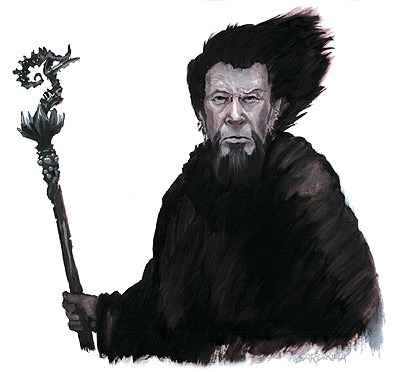
The Blackstaff
The companions agree that turning Waterdeep to their side should be their top priority, and so they go to the old sea elf post to await the “sign” from the mysterious ally.
When the PCs reach the sea elf post it is old and decrepit. They follow a raven to an old bell near the old submerged docks. A raven drops a tiny golden hammer into their hands and, taking it as a direct sign, they ring the hammer against the bell, surprised by the deep gong it makes. This summons the writer of the letter, who soon appears out of a secret tunnel that leads from here to the city.
Their ally is someone they’ve never met before, but he has played a role in our wider story, albeit a small one. Ages ago, when Jade and Verrick and the slime Lee went to Feylan and ultimately fell prey to Nazragul, there was a fourth person who was to go with them. Originally, that scenario had been intended as an easy way for the group to keep playing if they had a TPK while pursuing the Red Hand plotline. When the party didn’t need this, the fates of these NPCs became tied into Nazragul’s machinations. But this fourth person, described only as “an apprentice” was left vague and their fate uncertain.
Now it turns out that this is the Apprentice. He saw everything that happened to Jade and Verrick, but was teleported away by her power before she fully lost control to Nazragul. He fled Feylan and told Karina what he had seen, which is how she knew about the evil growing in Feylan, and why she moved the school to Vraath Keep, to begin fighting back against it. Meanwhile, this Apprentice became a statesman so that he could be her ally in Waterdeep. He is old now, but still loyal to Karina. His name is Nakir Dunspar. He tells the companions his story as he leads them through the sewers and into the city of Waterdeep.
He also tells them of the political situation in Waterdeep. The Open Lord of Waterdeep used to be marked by their possession of the Blackstaff, a relic last held by Laurel Silverhand, a very famous figure in Faerun (and D&D) history. When Laurel died, the Blackstaff was lost. The current Open Lord, an older elf named Vindass Lanteral, carries what he says is the Blackstaff but Nakir believes it is not the real thing. He says Vindass probably doesn’t know that he carries a replica, and if the companions can find the real thing, they could give it to Vindass and with it, he could sway the rest of Waterdeep to aid in the war effort. However, he is also afraid that even now, the Yuan Ti must plot against Vindass and seek to bring harm to him if he turns his support to the companions.
The party discusses the situation and decides to split up. Imoaza uses disguise magic and her arts of infiltration to set her and Carrick up as a mistress and her manservant and attend a ball at Vindass’ estate, where they sneak around and ultimately end up with Imoaza inside Vindass’ rooms, going through his belongings and looking for threats or scrying devices which she can trace back to the Yuan Ti.
Meanwhile, Milosh and Breathgiver have ventured into the city catacombs, to find the tomb of Laurel Silverhand and try and gather clues about where the Blackstaff might be. He finds a riddle written on Laurel’s tomb, that “I still hold the Blackstaff,” and, by sharing this with Nakir, they come to the revelation that the Blackstaff is actually hidden in plain sight, in the hands of a statue of Laurel that rests in a public park in Waterdeep. Thankfully, no one recognizes Milosh in his new form, as he is no longer a Frankenstein-esque metal monstrosity. He and Breathgiver make their way to the Statue and Milosh prepares to draw the Blackstaff.
“It can only be held by one whose heart does not waver,” Nakir had told him, when Milosh had said he was heading to get the staff. “That person must be prepared to give everything they have to the betterment of the people of Waterdeep.”
Now, as Milosh closed his hand around the staff, he asked himself the question... was he ready?
Milosh has to make a Charisma check to see if he can recover the staff and... he critically fails. The staff blasts him away and does not come free of the statue. It seems the companions may fail this mission after all, as Yuan Ti spies have been tracking Milosh’s movements and are beginning to close in on the park. If they discover the resting spot of the Blackstaff, they will destroy. But as Milosh is despairing of what to do next, his player has an idea.
“Could Breathgiver take the staff?” he asks.
It is a brilliant idea. A great story beat. A redemptive arc for the character that, when the party first met her, the players had despised for her enmity towards them. And so, as Milosh lays dazed on the soft grass of the park, Breathgiver approaches the statue, grips the staff, and pulls it free.
Holding the Blackstaff, Breathgiver is filled with power and freed from her curse and her obligation to Milosh. Her heart unwavering, she speaks the first words she has spoken since the Sea of Moving Ice:
“I would fight alongside you still, if you would let me,” she tells Milosh.
Meanwhile, Imoaza has made a disturbing discovery. In going through Vindass’ rooms, she finds a secret compartment with a journal that outlines his communications with the Yuan Ti. He is actually a Yuan Ti sympathizer, in league with them and hoping Abenthy will destory all humanity. Vindass’ hatred for humans descends all the way back from the War of Forgiveness, when the Alliance destroyed the area where his elvish tribe was from. This is a tie back to the plotline that plagued the party in the days of Karina, when much of her storyline dealt with how people thought she was a betrayer of the Alliance during the war.
Of course, just as Imoaza is discovering this, Carrick is keeping watch outside of Vindass’ rooms and sees Vindass himself approaching. This leads to a quick roleplay moment, where Carrick pretends to be weak and falls forward onto the floor, distracting Vindass and actually drawing his concern... Carrick is a half-elf, and Vindass shares a moment with him commiserating that his mistress doesn’t take enough care of him. He gently leads him from the hall to get him some food and water and medical attention, and Imoaza takes the opportunity to cast invisibility on herself and slip out of the door.
With this information, Imoaza and Carrick reach Nakir just as Milosh and Breathgiver are discussing with him how they should go about bringing the staff to Vindass. Forewarned, they change their plans. Nakir declares that Breathgiver must hold the Blackstaff for a while, for it has clearly choosen her, and they must keep her safe in the city until she can be revealed to the public in a grand way, thus stopping Vindass from making machinations to get the Blackstaff back. It is safer if the recovery of the staff goes unknown. Imoaza says she will use her knowledge of the Yuan Ti to feed them back false information about the Blackstaff while Nakir and Breathgiver go into hiding for the time being.
This was just one of the missions the companions take on. They end up being able to complete six of them, so five more await. We’ll cover those next blog post.
1 note
·
View note
Text
Part 91 Alignment May Vary: A Final Farewell to Haggemoth
I mentioned this last post, but if you are interested in playing through Haggemoth in 5th Edition, Robert Kendzie and I have updated it so you can do just that! It is one of the most entertaining modules I have ever played, and I can’t recommend it enough! Check it out here.
This post continues our multi-part Return to Haggemoth blog post. Having found a way inside Haggemoth’s Sanctum, the companions are now faced with finding the Inevitable rumored to have been trapped here for centuries. So far, they’ve found other interesting things, including spell sucking tentacles that are a harbinger of the end times; a strange creature who lives inside the Sanctum’s paintings, known as the Painted Mummer; another strange creature living in the paintings, this one a gnomish ally named Lhu-Ee; and signs of destruction and several deadly monsters. But they have yet to come across the Inevitable.
Finding the Inevitable isn’t their only goal, however. Milosh is also on a quest to rid himself of Illrastayne, picked up from a Marilith in Esheballa’s realm, and he’s been told the soul inside the sword made its contract here, in the sanctum.
This search leads the companions eventually to a thrice-locked door, a door which emanates such a powerful repulsion that it nearly causes Imoaza and Milosh to go mad from its effects. But they eventually find the keys hidden in Haggemoth’s Sanctum and open the door, to find an antechamber with yet another painting, this one of a Dark Tower. In the Tower the Mummer taunts them, telling them that if they go further, they will surely meet their end... and he encourages them to do so with glee, then slams shut the window to his tower and lets them make their decision.
They decide to push on, and they enter an unusual room.

Demonic Delight
This room is dominated by a huge hunk of obsidian, sitting at its far end. Floating above it is one of the most ornate lutes you’ve ever seen, and from it strums unspeakably sad music, pouring out like the tears of an angel to fill the space around you.
Carrick is a paladin, and his divine senses go crazy when they enter the room, alerting him immediately that something dark and evil lurks here. It is then that the sword Illrastayne rises from Milosh’s Warforged back and begins to strike at the companions, darting around the room quickly and dealing massive damage with each strike. This is what Milosh feels he came here to do: defeat the sword. And so he fights it, and with his companions, they defeat the blade, Imoaza’s Blackrazor finally cutting it in two as the two blades clash.
Yet, it feels too easy, too straightforward. Milosh turns to the lute then, and raising his Abyss Breaker gunarm, he blasts it into a thousand pieces.
And instantly, Milosh disappears, while the blade laughs a deep and terrible laugh.
Milosh found himself in an unexpected place. It was a pavilion, the inside of a huge tent brimming with decadence. Pillows were stacked comfortably in all corners of the pavilion, while hookahs and wine bottles lay amid the piles like preludes to greater comforts. There was only one other person here, and Milosh knew instantly it was not what it seemed, for the visage it wore (that of a Halfling Bard) it wore like a bad fitting set of clothes. The halfling’s features were bloated and shadows played across his features, darkening them and bringing its wide curves into sharp focus. His smile was too large, his eyes too small and too black. His red hair blew in a wind that wasn’t there.
He gestured to a devan in front of him.
“I think it’s time we talked,” the demon said.
The demon tells Milosh that he is pleased that Milosh brought Illrastayne here, for the sword was only containing his full power. He gives his name as Athica-Ickzaz, and tells Milosh that he doesn’t mind if Milosh knows it, for he will never be able to control him.
“The Halfing thought he could,” the demon says. “Fancied himself a warlock. And for a time, he was right. But I drove him to his death in the halls of White Plume Mountain, made him stick his head down a Manticore’s gullet. And at the very end I gave him just enough of himself back to realize what was about to happen.
“Even then, I was bound to him by our contract. But you’ve finally ended that. You’ve killed his last song. Now I am free to take another soul. Yours.”
Milosh argues, saying he is here to kill the demon and free himself, that he will never again be slave to another’s will and desires. But Athica-Ickzaz just laughs. He tells Milosh that there is no deal to be avoided here. Milosh’s soul is already his.
“I took it while you wallowed in self pity and misery. I took it the moment you failed your mission. I took it from you, and you didn’t even notice. I’ve been working on you ever since you first grasped my hilt in the Abyss. I didn’t bring you here to barter for what is already mine, Milosh. I brought you here to ask you a question. Three questions, actually. And I tell you what. If you can answer them all correctly, maybe I’ll reconsider.”
The questions are thus. Who are you? Who do you fight for? Who will mourn you while you are gone?
While Milosh is being asked these questions, back in the material plane, Imoaza and Carrick have been locked inside the room where the lute hung and are forced into combat against three Vrocks, flying demons with vicious claws and biting attacks, who explode into deadly spores when wounded. This battle turns dangerous fast, as I roll two critical hits against Carrick and Imoaza, dropping them down massively in health when they are already injured from their time spent in the sanctum. But they turn the tide, with Carrick giving himself magical weapons through his spells and divine smiting, so that he can injure the abyssal creatures, and Imoaza landing a critical blow of her own. She describes impaling one of the Vrocks against a wall, then withdrawing Blackrazor and in the same motion slicing its head off, before turning to try and help Carrick, who is flanked by the other two. Carrick fights with the ferocity of a zealot facing down his age old enemy, feeling the rage of Primus within his soul as these beings of Chaos try to bring him down.
Milosh, meanwhile, answers the questions. He is Milosh, nothing more and nothing less. He fights for himself. His friends will mourn him when he is gone. He says all of this with disdain, telling the demon with every answer that this little therapy session means nothing to him. That he has kept his mind focused on one thing: freedom. He won’t be turned from his course now.
The demon hears his answers, sometimes sullenly, and sometimes with anger. But when they are all spoken he simply laughs.
“Wrong.” he says. “There is but one right answer to all three questions. No one.
“You are no one. You do not have an identity because you are nothing but the tools of others, as you shall now be my tool.
“You fight for no one. You say you fight for yourself, but you yourself are no one. You want freedom, but such is the way of chaos, not balance! For what is chaos but the ultimate expression of freedom?
“You say your friends will mourn you when you are gone, but no one will mourn you, Milosh. They intend to have you save the world, and die in the trying. They want to use you as much as I do. But my way at least is more honest to the desire in your heart.
“But here,” the demon says with mocking care in its voice. “I shall give you one last chance to free yourself. One last chance to prove that you do not want my bargain. For I left the sword some time ago, and took up residence somewhere more suited to my power, somewhere already filled with the essence of the abyss.”
Here the demon points, and Milosh follows its gaze and feels his heart go cold.
“Yes. Your prized weapon. Destroy the Abyss Breaker and you can have the so called freedom you desire. I’ll grant you ultimate freedom, freedom from all bounds.” The demon laughs madly, knowing that Milosh will never do this, knowing that it has won.
Indeed, Milosh kneels before the demon then. “Very well,” he says. “I accept your terms.”
The demon smiles and prepares to accept his new acolyte, but as Milosh finishes speaking, he powers up the Abyss Breaker one final time and unleashes its energy into the weapon itself, blowing it apart and off his arm. Athica-Ickzaz has time to give one final astonished scream of fury before the blast overwhelms him, destroying him once and for all.
Moments later, the remaining two Vrocks, their claws poised to rip the throats out of Imoaza and Carrick, suddenly cry out in pain as they burst into flame, dying along with their master.
There is a massive flash of white light and then, falling out of that light, is a figure they have never seen before, though they know him. A Half Orc, with a curious tattoo burned into his left cheek, falls prone and naked onto the floor of the contract room. They only know it is Milosh because of a single piece of his armor that remains to him, a plate over his chest, with a circular indentation in it, inside of which whir moving mechanical parts. Otherwise, Milosh has been freed of all bounds, as per the demon’s boastful promise. He is no longer an instrument of the Surveyor, who bound him to the prophecy so long ago. He is now Milosh again, Milosh of Eberron, free to make his own future.
And the first thing he does is borrow some clothes from Carrick’s rucksack.

The Painted Mummer
Following Milosh’s unexpected transformation, the party gets a much needed short rest, which is all the time they can spare at the moment. Lhu-Ee warns them the Ethereal is still being torn into by the Abyssal plane due to Abenthy’s meddling, and something is specifically coming to this sanctum, though he cannot tell what. They are running out of time to find the Inevitable. Lhu-Ee also thinks he knows where the Inevitable might be, however. He is guessing it lies trapped in the rooms beyond the Sanctum, the place where Haggemoth set his final project, his great scales.
Getting to the scales presents one final obstacle. The doors to Haggemoth’s scale room are broken and blocked by fallen rubble. Lhu Ee says he knows a way past, but it is very dangerous.
He leads the PCs to a small room full of paints, where long ago Karina found and took a jar of Marvelous Pigments. She didn’t fully understand the significance of the paints back then. Lhu Ee shows this new group of adventurers the full power of them, power that has been amplified by Haggemoth’s tinkering.
The paints are how Haggemoth has created the Mummer and Lhu Ee, and the painted worlds. Now the PCs will have to use them to traverse those worlds to enter an unfinished painting in Haggemoth’s scale room. However, to get through the worlds, they must face the Mummer.
We set this up as both a battle of wits and a battle of combative ability. One PC must stay in the real world to paint the other two into the painted world. That PC can also control the painted world, to a degree, affecting the world to try and help the PCs. This uses their Wisdom score, and the Sleight of Hand skill for proficiency. Milosh volunteers to be the painter. Carrick and Imoaza sit by a wall and Lhu Ee tells them to try and clear their mind of any thoughts. He says this may feel a little weird. Then he begins to instruct Milosh on how to paint, telling him that, despite what he might think, closing his eyes might be a good idea, too.
“You need to picture them in your mind,” Lhu Ee tells him, “before you can paint them on the canvas.”
Carrick felt like his skin was running. He tried not to fight the sensation, though it was difficult. His mind was screaming at him that this was all wrong, that he was melting, he was drifting, he would never be whole again. Then the sensation stopped and he was no longer in the painting room. Now he was in the painted room, instead, a long stone platform arched by pillars. To either side were stars, an endless expanse of them. At the far end of the platform, in a stone throne, sat the half-grinning, half-scowling Mummer.
The air had a strange quality to it, Carrick noticed. It was thick, and he didn’t think he was breathing it so much as tasting it. It had an acrid taste, like bitter roux and rusty copper. The world was strange to look at. If he concentrated, the whole thing became oddly flat, like he was looking at a piece of paper with the background drawn on it. Yet when he moved, that background exploded into three dimensions all around him and he moved through it, each step shifting the perspective noticeably, so that moving didn’t happen as a smooth transition, but almost as if someone was rushing to keep up with him, painting the new perspective with each step he took.
Suddenly there was a twisting of the color about five feet away and Imoaza appeared. Only... she wasn’t quite Imoaza. This Imoaza was more snake like, having no legs, and a far more serpentine face. She slid across the ground on a thick body that ended in a thick, long tail. Her tongue flicked in and out of her mouth and when she opened it to speak, only hissing and haaahing came out. It was language, but the language of the Yuan Ti. Not one he spoke.
Carrick realized she carried a sword on her back. Black Razor, though it had changed, too. It was massive, shaped like a gigantic cleaver. It looked impossible to wield, but as he watched Imoaza reached behind her with a single slim arm and lifted it easily. The sword spoke in a deep husky voice, in a language totally alien to him: “Watashitachiha aku o uchi makashi, watashitachi no michi o susumimasu.”
Oops, Milosh thought, as he opened his eyes and saw what he had painted.
What follows is one of the most interesting battles we have ever run in over four years of this D&D campaign. Each turn, Carrick and Imoaza take actions, as they normally would in combat. The Mummer transforms himself into different giants to do battle against them. He also changes the setting, causing massive changes to the battlefield, like breaking apart the platform, making it slippery with ice, and causing it to run red hot with lava. Milosh can’t fight with the others, but he can try to outpaint the Mummer, redirecting his changes into something harmless or useful to the other players. In this way, we get some really interesting moments, such as...
The Mummer causes ice and sleet to rain down on the PCs. Milosh builds a tunnel over the platform to protect them.
The Mummer knocks Imoaza off the platform, but Milosh catches her by drawing a lower platform and then builds a set of stairs to rise her above the battlfield so she can launch attacks from afar at the Mummer.
The Mummer, as an Ice Giant, throws his throne at Carrick, and Milosh turns it into a wooden chair mid throw so that, while it still hits Carrick, it does far less damage.
The Mummer lifts the platform into a slide and causes a cascade of lava to rush down it, bringing him (in fire giant dreadnaught form) charging down it towards Carrick. Milosh draws a platform under Carrick, which lifts the Paladin up so that he can meet the Mummer’s charge. This is actually one of my favorite moments of the fight, and a major turning point, because Carrick uses a thunderwave against the fire giant and, normally, this would be a VERY easy save for the fire giant, because of his immensely high Con saving throw. But he actually rolls a failure and so is knocked prone by the thunderwave, at which point...
... Milosh has freezing water cascade over the lava, turning it to hard obsidian and trapping the Mummer inside. Then Carrick leaps onto the Mummer’s chest and deals him a critical blow, breaking his chest apart and exposing his heart, which he stabs viciously, ending the fight.
When the Mummer is defeated, his essence turns into a Painted Spear, a magical weapon that Carrick wields, and whose damage type he can choose before every strike. Then the PCs have to find a way out of the collapsing painted world. They do so, running through one of the paintings in the process (the painting of a dark tower they saw in the room before the demon). This is a tense moment, because in the tower they find a tear in the painted world that leads to the unfinished painting. With little time to spare, Milosh has to paint everyone through that tear, including himself (in a very strange meta moment).
The risk is high, for if Milosh fails to properly paint someone into the real world, they will simply melt into paint, destroyed forever (Carrick almost experiences this when he tries to push through the rip before Milosh has finished painting him, and watches his fingers begin to bleed away into wet paint).
They do manage to pass this section, though it is a close thing. Lhu Ee has enough power to keep his little corner of the painted world safe, and the players say that they will take him out of the sanctum and into the wider world, as a new companion, for which Lhu Ee is ecstatically grateful.

Inevitable
And so we come to the final room of this final dungeon. When I say final, I mean that this is the last dungeon in our game, though it is not the final encounter, not by far. Still, there is a definite weight of importance settling on our party as we tackle the last room. We are drawing close to the end, and everyone knows it. Now the final pieces begin to be put into place.
This room is massive, containing the forge Haggemoth used to build his final project, his scales meant to restore his soul. The edge of the room has no walls, instead terminating in an open pit filled with lava, with tunnels running further on into darkness. Over this pit there used to be a bridge, which in turn led to the aforementioned scales, but they were destroyed long ago by Abenthy, who then sent Haggemoth’s soul to Ia’fret. Haggemoth has since moved on from his lair, his soul freed when Ia’fret was destroyed in the final days of the Blood War. But there is one being still trapped in Haggemoth’s sanctum, an Inevtiable, trapped in stone by Haggemoth’s Golem ages ago, hundreds of years ago. The room is lit by the red hot glow of the lava lake that lies just beyond the cavern.
The Golem itself was defeated by Karina, Abenthy, and Bitterberry (in a fight the players are fond of remembering, as Karina landed several critical hits while blinded). Its husk sits at one end of the room and has decayed so that its mechanical workings are revealed. One of its arms, the group can see, resembles Milosh’ gun arm. Though he doesn’t have a gun arm anymore, Milosh can recognize the device and has a general idea of how to fire it if it can be powered up. However, he doesn’t know what it does, and he doesn’t know how to get it working.
Here, the players team up, each using their own proficiencies and backgrounds to solve this puzzle. Imoaza studies runes on the outside of the gun and determines that they will power the gun with the ability to fire a “Mud to Stone or Stone to Mud” ray. She surmises that this was probably used for excavation by Haggemoth and may be what trapped the Inevitable in the first place. Regardless, she believes it will free the Inevitable. Carrick uses his Surveyor’s knowledge to open up the gun and see how to rewire it to fire. Then the three come up with a plan.
Imoaza has the most deft fingers, so Carrick walks her through the steps of which wires need to be touching in order for the gun to work. He then prepares to unleash some of his spell power into the gun, powering the runes. Milosh is the only one strong enough to actually lift the gun and aim it, so he hefts the cannon up on his shoulder and points it at the rock, bracing himself to hold it steady.
Much can go wrong here. If Imoaza is not fast enough or precise enough, the gun will overcharge and release its magical energy in an explosion that will hit all of them. And if Milosh does not aim properly, they will miss their opportunity to free the Inevitable. Carrick only has enough spell power left for one charge, and they do not have time for a long rest, as Lhu Ee tells them time is running out... something is coming to the Sanctum through the ethereal. As if to punctuate this point, the earthquakes resume, stronger than ever...
“Now!” Carrick cried, shunting power into the gun. Imoaza held together the wires with steady hands and Milosh felt the power of the gun rushing through him, vibrating him down to his bones as it powered up. He planted his feet and gritted his teeth as the blast exploded from the gun. It was more powerful than he had expected. He could not see past the stream of power and had to trust he had aimed true. Then all at once, it was over. The gun fell silent, the ray ended, and in front of them there was a swirling of light and color and a voice which had not spoken in many centuries, a voice neither male nor female, though it leans more towards the feminine, addressed them:
"I am known as the Mardouk," it says. "I was... am... the Inevitability of Justice, though the title was taken from me and worn by another."
The Inevitable is too weak after its centuries of imprisonment to take physical form. It is only able to manifest in the dust left over from the destroyed rock, the dust glowing as it speaks and occasionally drifting together to suggest the shape of a large humanoid.
The Inevitable fills in the missing pieces of the prophecy, and explains the overview of what is going on, and what led to this point.
He tells of how he was summoned from his Hall on the plane of Mechanus by a dwarven wizard to cater to “the small matter of his soul.”
“Now,” the Inevitable says, “the one who has taken my title ushers in Chaos. Abenthy is trying to end the world, for he believes that in weighing the good against the evil, evil fills the world more, and to cleanse it is the only path forward. He does not know it, but he walks a path created for him long ago by Primus itself.”
The Inevitable tells them Chaos exists in all things. It exists even in Primus' creations. Angels, Devils, and the Ancient Dragons... they are some of Primus' earliest works, sprung from his battle with Chaos. The prophecy told of them coming together, the chaos within them allowing the power of the Abyss to be channeled directly into a single point, a single being. The prophecy also tells how to destroy it.
The Inevitable gives them a wealth of information on how the finale should play out. Friezurazov is the throne of power in the prophecy, a leyline in the world where reality can be weakened. It radiates power, and this power is what originally drew the Stone Giant Kirazov to the land, to make the Jarlberg (the seat of that radiation) his lair. Now Abenthy has taken that seat back and from there plans the end of the world.
He also tells them what the cryptic lines mean in the prophecy. A sword is needed, a sword created from the Abyss which can fight against it (Blackrazor). The stone is needed, to summon Primus at the end, for Primus must be destroyed as well (the piece of Surveyor’s stone Carrick recovered). But what he says next chills them:
“As long as Primus exists, so too will Chaos. That is balance. For Chaos to be wiped from this world, Primus must be erased from existence as well. This is the shield: a sacrifice one of you must make. For Primus will inhabit one of you, to make him mortal, and then that person will be destroyed.”
“It could be any one of you,” the Inevitable continues, and the rock dust forms into a finger which points at each of them in turn. “Imoaza, you have the ability to see and manipulate the weave. You could weave Primus into your own soul, and thus channel him. Carrick, you wear the skin of a Surveyor, a being made of Primus’ light. You could summon his full being into your body. And Milosh, you wield a chest plate forged in Mechanus. Primus’ hands forged it, and it can contain him for a time, if needed. But the decision of who is to make this sacrifice, of who is to be the shield, is up to you.”
This knowledge overwhelms the PCs as they look from one to the other, knowing that one of them will not, cannot, survive the final battle, if they are truly to win against Abenthy.
The Inevitable lastly speaks to Milosh: “Primus' source is needed, to cleanse the chaos from the soul it has infected. I shall give this power to you, Milosh, for only you, who bears the armor of Primus, can channel it.”
With this, the Inevitable’s voice fades, as armor and a forge hammer, made by Haggemoth’s own hands, rises from the pool of lava in which the scales once stood, the armor and hammer protected from the lava by the incredible magic built into them. They fly to Milosh and he claims them, gaining incredible defensive and offensive power. Then the Inevitable channels itself into MIlosh’s chest plate, giving him the last of its power. Milosh gains an insanely powerful blast, a divine judgement that unleashes radiant energy in 60 feet around him... but which can only be used once per day and which costs a 5th level spell slot.
It is the power which can strip Chaos from a soul.
Before the PCs can spend much time contemplating their new discoveries, Lhu Ee cries out that something horrible is breaking through into their world!
As he says this, the place begins to shake as earthquakes rip through it. Ethereal tentacles push through the fabric of reality, whipping all around the players, distorting reality wherever they touch. A massive tear cuts through this plane and something else emerges into the cavern. Tearing its head through the rip in space time comes the Tarasque, the great beast last seen at the Maakengorge. It opens its maw, roars, and goes immediately for Milosh, snapping him up in its jaws.
... and that’s where we’ll end this blog post, at least in terms of its recounting the story. There is one last thing I wanted to address, and that was a question the players contemplated at the end of this session. The question was whether this plot line has been “inevitable.” Could they have let the Inevitable free all those years (2 1/2 years real time, some 100 years game time) ago? Would that have derailed this massive build up to the end game?
The answer is that none of this was set in stone (no pun intended). The ending that is coming is very much built off of their actions. Most of the game has gone like this. I have planned very little, and I don’t lock in plans until generally a session or two before we reach them. Even then, locking in is a very generous word.
Milosh’s transformation is a good example of this. I had ZERO idea that Milosh was going to shed his robotic form and return to his original one. It just fit with the moment and with what I knew about Milosh’s character from how the players has portrayed him. It was the arc Milosh was describing to me. I just described the conclusion that he was steering towards.
One thing my players point out is how well the pieces have all fit together, especially when the Inevitable points to each of them and explains how each could channel Primus. They say it feels like this was planned from the beginning. And again, I can only say that it couldn’t have been. I did not know that these three characters would even exist when we started playing this game. Even the Prophecy itself originated as a piece of throwaway description, a mural on a wall inside the Temple of the Maakengorge because a player asked me to describe the walls and I wanted something mysterious and tied in to characters they knew. From there, it just grew to fit all the pieces of the story that had been unexplained.
Same with the Surveyor and even Primus. Those plot points came about because I wanted a way to tie Carrick’s player into the game, as he was new to it and the other players already had 2 years of story under their belt. I needed to tie him very directly into the plot, so that he (and they) would see his character as being as important as they were. Thus, I threw in a detail about a clone of Carrick in the Yuan Ti Fane that they come across. I had no idea where this was going at the time, but eventually it became the plot about the Surveyor.
It’s funny, because it does really feel like the prophecy and the Surveyor have been here since the beginning. But that’s because I tied them back into the Jade Statue, and the Sunken Temple, which was literally how we began the game.
Not planned, but always looking to be tied in. Details of the game were never forgotten, in large part because of these blogs. They, more than anything, have been the tool that has allowed me to tie so much together in the end.
That it has all worked out to feel “inevitable” is something I take as a huge compliment, a sign that I was able to weave the threads the players gave me into something coherent; something that was better than a predetermined story, because its pieces belonged, inexorably, to them.
We’ll get closer to the conclusion next time, as the game enters a very interesting phase, with some new mechanics to represent our epic level of play (they players are all level 19 now).
1 note
·
View note
Text
Part 90 Alignment May Vary: Pieces of the Past
There is an adventure for 4th Edition called something like The Return to the Tomb of Horrors. It is an adventure centered around the infamous lich Acererak and his various Tombs of death. One of the more fun parts of the adventure takes PCs to the Tomb of Horrors... only it’s decades after the Tomb’s first opening and the tomb has been raided and destroyed by the thousands of PCs that have come to it since that time.
I mention this, because ever since I read that module, I’ve wanted to do something similar: bring players back to a place that was familiar to them. The Tomb of Haggemoth, which featured so heavily in our campaign and plot, was the obvious choice and there was at least one loose end left in the Tomb that I felt would serve as a good hook: an ancient celestial being, trapped in a rock. Around the time of this session, I had finished working on a revival of Haggemoth, bringing it into 5th Edition with its original creator, Robert Kendzie (you can learn more about that here). As we updated a lot of the final dungeon, it felt like I now had an appropriately “changed” setting to bring the players back to.
So for this next section of the adventure, we return to the past. We return to Haggemoth.
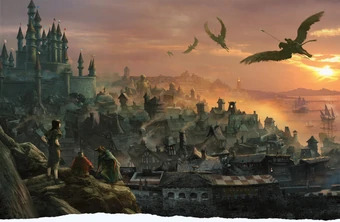
New Waterdhavians
The set up for this return begins in Waterdeep, with Imoaza and Milosh morose after the failure at Maakengorge and the sacrifice of Ruze. Milosh especially, has lost his entire sense of identity and nearly quits the group entirely. His only consolation is that armor has been left for him by Vraath Keep’s smith, who had promised to build him a new face. It is a wonderful piece of armor that gives him a humanoid looking face shield to cover up the damage done by Dragon fire back on the asteroid. But he also saw that smith dead in the Maakengorge temple. Everything reminds him of his failure at this point. Only one thing keeps him involved: Illrastayne.
This is the blade he took from the Abyss, the blade which contains the soul of the bard-turned-warlock Bitterberry (and his Demonic patron) and which Milosh used extensively in the Abyss but has shunned since. He decides to rid himself of the blade, almost on a whim. He is aware that it has a demon inside of it and wishes to have no connection to anything which might impede his freedom, whether it be Surveyor, Primus, or this accursed sword. But when he tries to rid himself of it, he finds he cannot. The sword will not leave him. More than that, it taunts him, telling him in a demonic voice inside his head that in his despair, the blade has latched ever more deeply onto his heart and soul and that soon it will have him completely. Determined to find a way to destroy the blade, Milosh seeks out the Shaman from the ice tribe, who survived the events at the Maakengorge and is with the refugees in Waterdeep. The Shaman tells him there is a place called Rori Rama, where the first contract between the Demon was struck and that is the only place now where the blade can be destroyed.
It is around this time that Carrick returns to the party. Yes, Carrick! If you don’t recall him, he was the prior character that Ruze’s player had created and played for many many sessions, finally losing him in the Abyss during Esheballa’s insane game. But that was only the end of the original Carrick. Carrick’s backstory involved the inadvertent merging of his soul and personality with the energy of the final Surveyor, and so when Carrick died, his soul was borne back to Faerun to awaken in the last vessel the Surveyor had left there: a final body left safely in the ruins of the Fane, whose Yuan Ti temple had been reduced to rubble by the actions of Imoaza, Aldric, and the original Carrick during the final campaign of the Red Hand.
Carrick comes to Milosh and asks him to accompany him on a final task. You see, Carrick has worked out a good portion of the prophecy and its meaning. He believes that the players haven’t actually failed to stop the prophecy. Instead, he tells them that this is what HAD to happen in order to stop it: the three had to be one. Only when together could they be defeated. To recap, according to the prophecy, the PCs will need to bring together four objects to destroy the three and halt Chaos’ advance into the world. The pertinent lines are thus:
Four things must gather to alter fate’s course The Sword, The Shield, the The Stone, The Source Then upon the throne the three must be Before they can meet their destiny
Carrick says the sword is almost certainly Imoaza’s Black Razor. The Stone he believes is a piece of the Surveyor’s Jade stone that caused so much trouble early in the campaign, years ago. He went out on a mission of his own to retrieve it (one that wasn’t played in the course of our adventures, but was occurring while the players were at the Sea of Moving Ice). In speaking with Imoaza and learning what she found out from the library on the iceberg, Carrick now believes the Source is a piece of Primus himself. Karina, before her demise, had spoken to him at length of her past adventures and mentioned that Abenthy had begun calling himself an “Inevitability of Justice” after surviving Haggemoth’s tomb. Carrick, with the knowledge of the Surveyor living within his own memories, knows of the creations of Primus, and Abenthy’s wording stands out to him: “Inevitability.” Carrick believes an Inevitable is still in Haggemoth’s Tomb and that Abenthy encountered it. The Inevitables are celestial beings, created by the hands of Primus itself in the plane of Mechanus, where Law and Order is unquestionable. And there is one being, Carrick believes, who can channel the power of that Inevitable.
“Oh great,” Milosh said, seeing the visage of the surveyor looking down at him from the alley’s entrance. “This again.”
Years ago, a surveyor had taken Milosh from the depths of failure and despair and built him a new identity. But now Milosh had remembered, remembered everything, and again he had failed. He didn’t want a third chance. He wanted to go away. He wanted the world to go away.
Carrick knelt beside him. “We’re not very different, you and I,” he said. “Both of us have experienced death. Each has had our own failures. And we’ve been brought back to do more. We have been brought back to save the world.”
Milosh scoffed. “I have no world.”
“No. You have a million. Every world is yours to protect. That was your mission. It is your mission.”
“I’ve lost a lot already.” Milosh paused. “You remember Aldric, right? Did you know Imoaza killed him? I found it out from a book we got, from this old elf in a frozen library. You trust this group to save a world? We can’t even trust each other.”
Carrick stopped and considered what Milosh had said. “We all have to answer for our past actions,” he said. “Some answer in different ways. I believe Imoaza is going through her own changes. And I... I am no longer exactly who I was before. I am not Carrick. But I am not the Surveyor, either. But I am both. Do you remember the sacrifice I made as Carrick? Sometimes sacrifices have to be made. Sometimes we can avoid them. But if you walk away here, you walk away from the sacrifices we have all made.”
“Maybe I don’t care.”
“You’ll also walk away from yourself. You want freedom? Then you need to face what it is that you are afraid of. Or else you’ll never be free from it.”
While Milosh is struggling to come to terms with what he should or should not do, Imoaza begins to investigate the politics of Waterdeep, concerned by the boast from Nazragul that he had agents in Waterdeep’s council, planted there to change the teleportation destination from Vraath Keep to the Maakengorge, which is how he trapped Karina. Her investigations, which involve her ingratiating herself to certain people in disguise and exploring the homes of certain nobles, reveals to her that Yuan Ti have infiltrated Waterdeep and are turning its citizens and lords against the cause for which Imoaza and the companions fight.
These discoveries will have importance for upcoming sessions, but for now they linger as unresolved hints of danger, for it is time for the group to head to the tomb.

Return to the Tomb
“The island was warded against dragons,” Argent explained, as the bronze dragon circled down towards the island of Rori Rama. “We knew where it was, we could practically taste the magic and gold Haggemoth had accumulated, but we couldn’t get close to the island. Like an itch you couldn’t scratch. Even now, this is as close as I can come.”
For three weeks, the companions (plus Breath Giver, Milosh’s personal healer from the ice tribe) had flown via dragonback away from Waterdeep, across the Moon Sea, and towards Rori Rama, to find the Inevitable trapped inside the old tomb. They had stopped at several locations which would have been familar to Karina. They had stopped to buy provision in Ottoman’s Docks, which had changed little in a hundred years, except that it had doubled in size. They had roosted one night on a beach of a deserted island with a huge spire rising out of its middle (the site of the LaCroix mansion, though they didn’t know it). They had flown to Celaenos and spent a night as guests of the Sisters, the Keepers of the Library, who had taken over the monastery after the Knights had been murdered decades earlier. They spent a night at the island of the Oracle, and though they lacked the money to see the ageless Oracle, the monks who protected her let them at least stay on the beach for free.
Eventually they reach Rori Rama, but the closest Argent can get them is at the base of the inactive volcano which contains Haggemoth’s tomb. Breath Giver stays with Argent while the three companions use fly spells to reach the volcano’s crater and there find a way down a mysterious shaft delved into the mountain itself. The shaft takes them directly into Haggemoth’s inner sanctum, skipping the first level of the tomb entirely (I intend this to be a revisit of this infamous area, not a full rerun of it).
This high ceiling of this long chamber is held up with stout columns and the floor is tiled in marble. The rotting remains of a pair of couches can be seen towards the center of the room, along with some long-dead potted plants. Several doors lead off of this room, though some are damaged. The space is lit by arcane-looking lanterns hung from the columns, but the far end of the hall is lost in shadow where part of the ceiling has collapsed and the lamps have failed. Strange sounds echo in the distance – sounds of movement and the occasional animal like cry.
I am not going to detail all of the explorations the players make of the old tomb. There are many little rooms and surprises the players encounter, but only a few are of key importance to the plot, and I want to focus on those, the things that have changed for the worse since the last time they were here.
First, there is a new character that makes his appearance in this ruined tomb. His original name is unknown, if in fact he ever had one, but the group comes to know him as “The Painted Mummer.” He lives in paintings left behind by Haggemoth, and takes multiple disguises, different for each painting, from a feasting king to a hunchbacked dwarf. He interacts with the PCs as they explore the Sanctum, sometimes giving them dubious advice, at other times leading them through interactions with some of Haggemoth’s left over magics. For instance, they try to make a potion of invulnerability in his old study, guided by the Mummer in the guise of a twitchy scholar in a painting in the room. This ends in disaster as the potion explodes, due to them not identifying the proper heart needed for the potion (they use a Grell heart instead of a Hook Horror heart). They do get some hints that not all is well, such as when they identify some dead bodies hidden in a painting of a snowy mountain, and occasionally even get a glimpse of the Mummer’s real persona, a gaunt, tall figure dressed in skin tight black and wearing a theatrical mask, one half of which is sobbing and the other half is giving a menacing and angry snarl. Eventually, they learn to be wary of the Mummer and start burning his paintings whenever they find him in them. This only angers him the more and he begins to stalk them from room to room, not always able to do anything to them, not always even seen by them. But he watches, and he waits.
Cliff notes: The Mummer was an idea Robert and I came up with for the 5th Edition version of Haggemoth. He wanted to do more with the Inner Sanctum and was interested in maybe using the paintings to have some effect on the environment. I was thinking of GladOS from Portal, and liked the idea of an insane groundskeeper, something which was initially built to be helpful but has become broken and corrupted by time.
Secondly, while they explore, the PCs are occasionally accosted by otherwordly purple tentacles, that seem to sprout from the air itself, or the floor. The Ethereal, they discover when Milosh tries to enter it, has been completely dominated and overtaken with these tentacles, and they attack the PCs on two major occasions, sucking out not only their life, but their spell power, draining their spell slots and destorying their magical shields and other effects. The most memorable fight against them takes place in the old dining hall, where an unnatural darkness forces the PCs to fight blind against the tentacles, all the while looking for a key to a special door in Haggemoth’s Sanctum. The PCs get very creative here, with Milosh destroying parts of the ceiling to drop on the tentacles, Imoaza using the Weave Sight to be able to locate the Tentacles, and Carrick using fire and ingenuity to set up a kind of napalm effect that he uses to keep the Tentacles away from him. The scariest part is when the Mummer causes dozens of animated knives and dishes to animate around the room and swarm the players, only to have the Tentacles latch on to this living magic and erupt from the cutlery and dishes, surrounding the players with swarms of essence draining tentacles!
Another scary room involves an illusion created by the Mummer with the aid of some hallucinigenic spores. This grabs Milosh especially, and he runs into what he thinks is a vision of his old life on Eberron, where he is at a ballroom dance. He happily joins in the merriment, and takes a bite out of a thick pastry of some kind, bursting with whipping cream and flavor.
Only, what’s really happening is that he’s surrounded by Rust Monsters, absolutely attracted to his metallic form, his addled mind showing them as laughing and dancing humans. Imoaza and Carrick see through the illusion before he does, and watch as he takes a bite of what he thinks is a pastry... it is actually a larval Rust Monster, its guts and ichor spraying across his face as he bites into it.
Suffice it to say, this is not an encounter that the PCs end up liking, but it is a memorable one. By the time it is over and they flee the room, Milosh has had half his face (just restored!) eaten off.
They eventually discover a scrap of painting in a room which also contains the broken summoning circle Haggemoth used to summon the Inevitable of Justice, centuries ago. The painting shows a gnome, who swears he is not the Mummer, but seems terrified of the Mummer. He tells them his name is Lhu-Ee and he is the last surviving painter dweller, aside from the Mummer, who murdered all of the others. He explains that the paintings were created by Haggemoth to hold his knowledge and to keep him company. They are like phylacteries, holding the souls of creatures Haggemoth pulled from beyond the grave to shape to his purposes. When he prepared to depart this plane, he “turned off” the paintings, intending to let the souls rest forever. But something went wrong. Others (Karina, Abenthy, Xaviee, and Bitterberry) came into the Sanctum and their presence awoke the Paintings again. But with no Master to direct them, the Mummer went mad. Originally designed to entertain Haggemoth and be a companion for him, in his absence he declared that the paintings had failed their master and needed punishing. Only Lhu-Ee escaped his wrath, by hiding in a torn scrap of painting. He offers to go with the party in his scrap, if they’ll keep him safe from the Mummer.
Lhu-Ee knows more than just the history of Haggemoth. He is an expert on the Abyss and the Ethereal, filled with Haggemoth’s knowledge of those planes. He tells them that what’s happening to the Ethereal now is a sign of a being trying to weaken the boundaries between this plane and the Abyssal plane, with disastrous results.
“Why,” he says, pushing his oversized turban back up on his head, where it promptly falls down again. “It could be the end of the world!”
* * *
This is part one of a two part post. There’s a lot that needed to be set up this time, so I wanted to break the posts up to make it a little more manageable. And ya know, maybe also stretch this blog out just a little more. We are coming close to the end.
But not quite yet! Haggemoth’s final resting place still awaits the players, and more beyond that!
2 notes
·
View notes